How to Perform a SWOT Analysis on Your Company with a Market Research Tool
How to Perform a SWOT Analysis on Your Company with a Market Research Tool
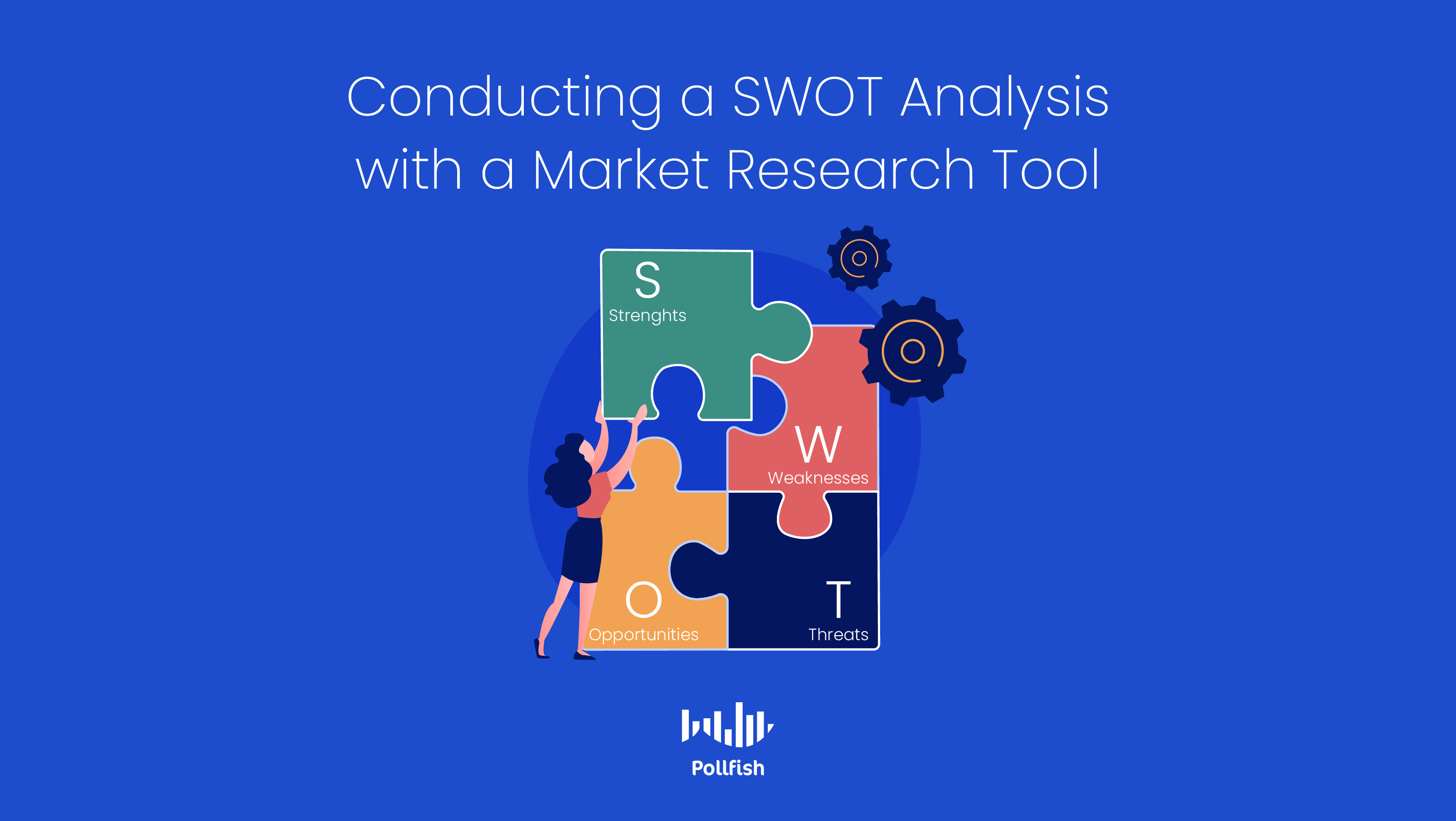
A SWOT analysis is a simple framework that goes a long way towards helping businesses develop their strategic planning process along with grasping their own stance in their industry. In turn, this kind of analysis allows them to make informed business decisions.
This is because all businesses have their share of strengths and weaknesses, and no company exists in a vacuum. As such, you should analyze the opportunities and threats that pervade your market to take advantage of your scope of opportunities while steering clear of threats.
A SWOT analysis allows you to do just that, in turn enabling you to understand your company’s position in your market or niche and use this knowledge to take scalable actions.
This guide explores the SWOT analysis, its importance, how to conduct one for your business and how to use a market research tool to complete your analysis.
Understanding the SWOT Analysis
Also called the SWOT matrix, this analysis is a kind of strategic planning technique businesses use to identify internal strengths and weaknesses and external opportunities and threats. Its components are laid out in its name, which is an acronym for strengths, weaknesses, opportunities and threats.
A SWOT analysis is a visual study tool that identifies specific strengths, weaknesses, opportunities and threats and presents them in a diagram that takes the form of a two-by-two grid.
This grid features four quadrants; each one represents one of the letters of the SWOT and its concept. Each quadrant houses the list regarding the concept behind the letter. This format organizes the elements as internal versus external.
You can conduct a SWOT analysis on an entire organization, or on individual projects in a single department. Aside from evaluating a company or project, a SWOT analysis is used to determine how closely a business is aligned with its growth trajectories and benchmarks. Additionally, it is used to gauge the performance of a specific project, such as a PR campaign based on preliminary predictions.
A SWOT analysis is most ideal when diverse groups or voices within a business provide actual data points rather than suggested messaging.
The Makeup of a SWOT Analysis
The SWOT analysis is made up of a grid with four quadrants, which represent each letter of the SWOT. To understand which quadrant an idea belongs to, you ought to consider strengths and weaknesses as internal factors, as they deal with the organization, its people, workflows, processes and assets.
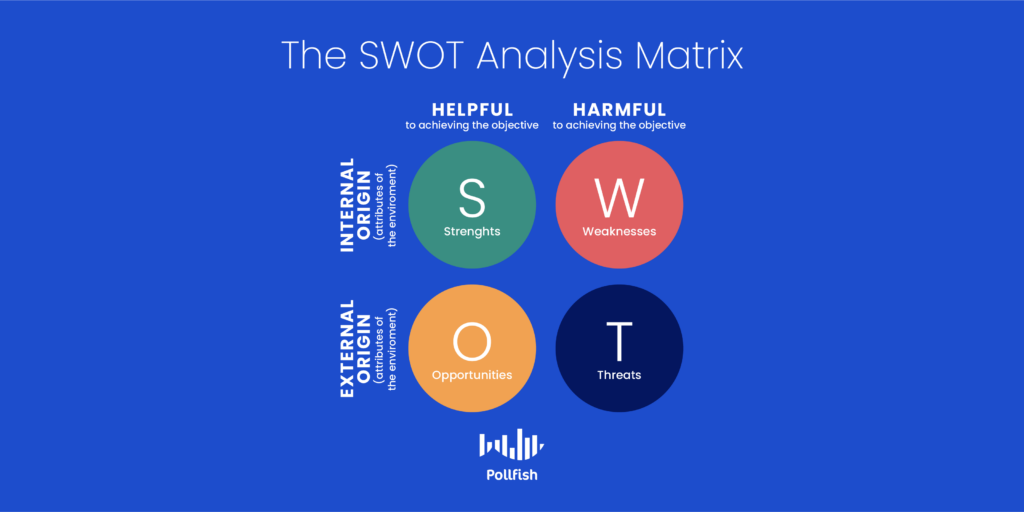
On the other hand, opportunities and threats are external factors, given that they originate from your niche, your competition, your market and the wider economy. The following explains each element of this framework in detail:
Strengths
This element pertains to all the things your organization excels at and how you are distinct from your competitors. It, therefore, involves your advantages over other businesses, which include your price range, quality of service/products, customer experience, access to certain materials, employee satisfaction, manufacturing processes and more.
Since your strengths empower your organization, consider the factors that make it operational. Answer the following questions for the Strengths portion of your analysis:
- What does your business do better than others in your industry?
- Which business processes are successful?
- What assets do your teams have? (brand equity, knowledge, education, network, skills)
- What values drive your business?
- What kind of physical assets do you have, such as equipment, technology, cash and patents?
- What unique or valuable aspect does your business have?
- What kind of low-cost resources can you draw upon that your competitors can't?
- How are you innovating your products and business processes?
Virtually any aspect of your business can be considered a strength if it brings a clear advantage to your business. If all of your competitors provide a certain aspect, then it becomes a necessity, not an advantage.
Weaknesses
While admitting the weaknesses in your organization may be unpleasant, these truths are critical to aggregate and examine as soon as possible, as you can only mitigate them when you accept them.
Given that weaknesses are innate to your company, you should map them out by focusing on your offerings, systems, people, resources, and procedures. In the weaknesses quadrant, mull over all that you can stand to improve and the kinds of practices your company must avoid.
To do so, you’ll need to consider — and possibly uncover — how others in your market view your business. These actors, which include your target market, competitors and media outlets in your niche may notice weaknesses that you are not aware of. As such, to complete this section, investigate how and why your competitors are doing better than you to come to terms with what you lack.
Use the following questions for the Weaknesses portion of your analysis:
- What are some of the things that your business needs to be competitive?
- Which areas of your business generate the least ROI?
- Are there any aspects of your business that require more resources? (Such as a department, a project, etc.)
- Which business processes need improvement?
- Are you lacking tangible assets such as money, space or equipment?
- Are there any gaps in your team?
- Is your location ideal for your success?
- What areas are your competitors excelling at which you aren’t or not as strong as they are?
All in all, weaknesses are the negative factors that detract your business from its strengths. You ought to consider how to reduce them, along with your key areas for improvement to remain competitive.
Opportunities
This section involves all the openings and probabilities of something positive happening to your business, whether it is publicity, higher profits, greater ROI, a larger social media following and various other business matters. You must claim opportunities for yourself, as the nature of an opportunity is that of an external situation which you must look out for so that you can use it to your full advantage.
Opportunities take the form of developments in your market, whether they are technological, service or experience-related. When it comes to being competitive in your market, spotting and using opportunities makes a major difference to your business. At times these opportunities allow you to position yourself as the leader in your industry.
At other times, opportunities can take the form of small advantages that can still effectively shape your competitiveness. These can be present in both market trends and cultural trends.
You should also anticipate changes in government policy related to your field. These can involve regulations that create barriers for your business. Additionally, take heed of changes in social patterns, population profiles and lifestyles, as all of these can offer opportunities.
Use the following questions for the Opportunities portion of your analysis:
- What interesting market trends are you aware of, large or small, which could impact your business in a positive way?
- If your market is growing, are there trends that will encourage people to buy more of your products and/ or services?
- What events can your company take advantage of to grow the business?
- Are there any imminent changes to regulations that might affect your company positively?
- Why kind of content opportunities can you execute to your advantage?
- Are there any current events or cultural trends that you can capitalize on?
- Are your vendors or manufacturers offering any perks or bargains that your business can benefit from?
- Do you receive cold emails with opportunities to either be featured in or collaborate with a media outlet or company in your niche?
Threats
This element includes anything that can negatively affect your business from the outside, including, but not limited to higher standards in market requirements, supply chain issues, shortage of employees, negative press and more.
No matter your revenue or standing, you should always anticipate threats to your business and be prepared to take the necessary action to thwart them before they take a toll on your business and stunt your growth.
Threats can arise from anywhere; as such, consider all the obstacles you contend with in getting your product to market and selling it. These can easily include constant changes to quality standards or specifications for either your products, services or overall CX (customer experience). You’ll need to adapt to these changes if you intend on being competitive.
Additionally, although changes in technology are generally viewed positively, they can present threats to your business. As such, you should be wary of these changes so that you can adapt to them before they become true threats.
Use the following questions for the Threats portion of your analysis:
- Do you have any potential competitors who may enter your market?
- Could upcoming developments in technology change how you do business?
- Have any media outlets spoke negatively about your business or focused their attention on praising your competitors?
- Will your vendors always be able to supply the exact materials you need at the prices that you seek?
- Is customer behavior changing in a way that could have a negative impact on your business?
- Are there any issues with your employees that can lead to high turnover and negative reviews?
- Are there any regulations the may have negative consequences on your business?
- Are there any market trends that could potentially become a threat?
Although threats are external and you have no control over their presence, you can still keep them at bay by conducting various market research techniques.
The Importance of a SWOT Analysis
This kind of technique is important on several fronts. First off, in a general sense, it allows you to make well-informed decisions, as it makes it possible to prioritize the work that you’ll need to do to grow your business.
Understanding your company's position in your market or industry is crucial for any business in that it allows you to strategically develop your business and avoid wasting resources, efforts and time. This is crucial for various situations and scenarios, whether you’re trying to expand into a new market or compete with a surprise contender in your industry.
A SWOT analysis provides a comprehensive and unbiased overview of your entire business or a specific campaign or product. It forces you to consider every factor that could affect your project or business in one way or another. This is especially useful if you’re dealing with difficulties or lack confidence in your current strategy.
This is because a SWOT analysis offers all the details you’ll need to make actionable plans. The four quadrants grant you an easy way to organize your insights.
This analysis helps your business operate more strategically, thereby granting you a better chance of reaping success. This is because it addresses what your business lacks, which allows you to minimize risks. It also pinpoints your greatest advantages and chances of success.
A SWOT analysis can be used to jumpstart your strategy whether it is in an informal or full-fledged way, as this tool can serve both approaches.
Finally, you can also use it to better understand your competitors and their standing. This kind of intelligence lessens their threat to your business, as you can form a competitive narrative for your business, based on your analysis of your competitors.
Performing a SWOT Analysis & The Need for Conducting Primary Research
In order to form a holistic SWOT analysis, you’ll need to dedicate a significant amount of time to formulate it. But not to worry, there are several steps you can follow and tips to take into consideration.
Additionally, you can objectively strengthen all of your SWOT analysis efforts with a market research tool. Whether or not you decide on using a market research platform, you’ll need to conduct market research for your analysis regardless. This is because this analysis is composed of data and insights from both your company and the market at large.
While conducting secondary market research is inevitable and necessary, this kind of research alone is insufficient for a SWOT analysis. Consider this: you’re going to need answers to questions concerning both your company and market, both of which secondary research doesn’t provide all the answers for.
In fact, many secondary sources may be loosely related to your business concerns, but do not answer the specific questions you require answered to adequately fill out your SWOT analysis.
When you carry out your analysis, be realistic and rigorous and use a strong market research tool with various capabilities that ease the process.
How to Perform a SWOT Analysis with a Market Research Tool
The following explains how to conduct a SWOT analysis with the use of a market research tool. Remember, market research plays a major role in executing this technique properly.
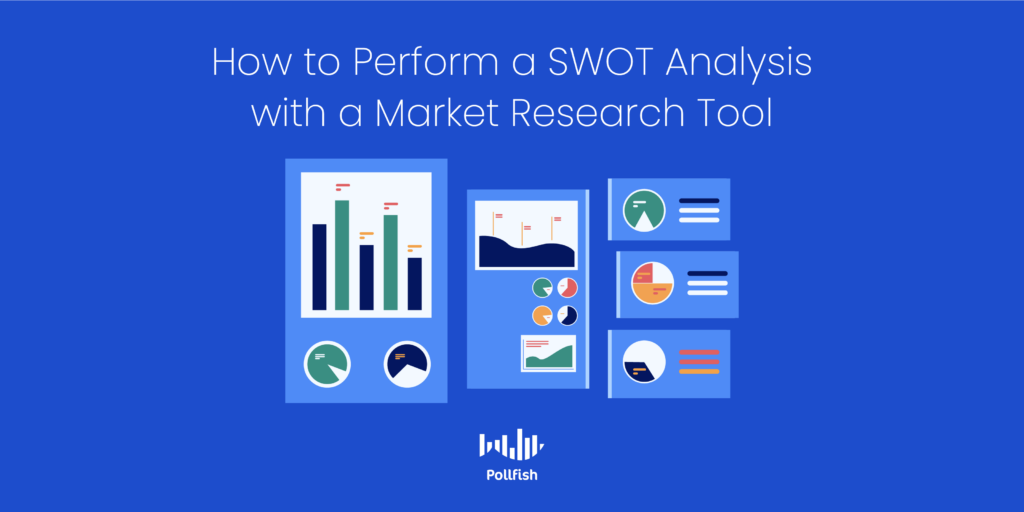
- First, create the SWOT Analysis matrix, made up of the four quadrants. The following image shows what it should look like.
- Next, determine the objective of your SWOT analysis.
- You should aim your SWOT analysis on a specific objective or campaign to reap value from it.
- For example, you could perform a SWOT analysis to help you decide if you should create a new product, change your CX or internal processes.
- Conduct secondary market research on your business, industry and market.
- Study trade magazines, news websites, industry sites, reports, blogs and even social media accounts pertaining to your industry.
- This includes studying your competitors through internet research and designated competitor research tools.
- Examine all the available resources that detail your customer buying behavior, preferences, lifestyles and more.
- Using the explanation and question examples in the section on strengths, list your business's strengths.
- These involve your financial resources, physical location, cost advantages, product features, brand visibility, customer experience, consumer loyalty and more.
- This also includes employee relations. This is where a market research tool comes in handy. This kind of tool allows you to understand how your workers view your business and can point out their problems, concerns and desires to determine your strengths and weaknesses.
- Conduct primary research on your employees with any of the following surveys:
- List your business's weaknesses. Use the above question examples and explanation as reference points.
- List things that you consider to be weaknesses, such as the things that put your business at a disadvantage when compared with others.
- They can include a lack of new products, customers, staff absenteeism, a lack of intellectual property, declining market share, distance to market and a low customer lifetime value (CLV) among your customers.
- Check on these for accuracy, given that, as time progresses, your weaknesses may change or dissipate.
- When you review your SWOT analysis after a year, your weaknesses may be resolved, a clear sign of progress.
- Survey your customers to detect any weaknesses. Using the following surveys:
- Product satisfaction survey
- Customer satisfaction score survey (CSAT survey)
- Customer effort score survey (CES survey)
- List the potential opportunities for your business. Refer to the above question examples.
- Consider different external opportunities for your business. These are not your internal strengths and are not definite.
- One opportunity for business could be a threat to another.
- Do not list the same item as both an opportunity and threat. You should weigh the benefits and drawbacks of a seeming opportunity before you can determine if it indeed is an opportunity or a threat.
- Opportunities include new technologies, training programs, partnerships, a diverse marketplace, new talent, new campaign ideas and a change of government policy.
- Survey your vendors and partners to discover opportunities with B2B surveys.
- Identify your target market with an online survey platform.
- Find cultural opportunities by using surveys to unlock cultural trends.
- Segment your target market via market segmentation with surveys.
- List the potential threats to your business. Refer to the above question examples.
- List all the external factors that could cause a problem for your business or threaten it in any way.
- Threats include high turnover, disgruntled workers, unsatisfied customers, rising unemployment, increasing competition, higher interest rates and the uncertainty of global markets.
- Discover any latent and overt threats by using a market research tool to create the following surveys:
- Establish priorities based on analyzing the SWOT matrix.
- Create 4 separate lists on each SWOT element.
- Display them side-by-side so you can have a clear visualization of how your business is running and all of its issues.
- Prioritize the most pressing issues along with categorizing those that can be dealt with later.
- Develop a strategy to address the issues in the SWOT.
- Review the foremost issues in each of the four elements.
- In order to work through and resolve the issues, consider the following questions:
- How can we overcome the threats we identified?
- How can we make the most of our opportunities?
- How can we use our strengths to take advantage of the opportunities identified?
- What do we need to do to overcome the weaknesses we identified to take advantage of the opportunities?
- How will we minimize our weaknesses to eliminate the identified threats?
- After you have contemplated these questions and came up with practical answers, use the SWOT analysis to develop strategies for achieving your goals.
- Don’t stop testing or conducting primary market research. Use your market research tool for A/B testing, sending personal surveys to exact targets via the Link Distribution Link feature and extracting any kind of customer information you need.
Supporting the SWOT and Beyond
A SWOT analysis is a strong tool that allows you to understand how your business is faring in your industry, while laying out external factors about your competitors and the industry at large. While you may offer competitive products and good prices, external factors will always affect your business.
In order to perform a SWOT analysis, generally stay informed on your customers and industry and remain competitive, you’ll need to conduct market research. Secondary research provides a useful starting point for studying all of your external factors, from your competitors to how others view your own business.
But it is primary research that will provide you with the most valuable insights. With a potent market research tool, you can easily gather all the insights you need about virtually any topic. A strong tool will make it easy to create and deploy surveys to your intended audience.
When you’re deciding on the best market research tool for your organization, seek one that offers a mobile-first platform, as the use of mobile devices dominates the digital space.
It should also include advanced skip logic to route respondents to relevant follow-up questions, use artificial intelligence and machine learning to automatically remove low-quality data, offer a broad range of filtering data options and engage respondents in their natural digital environments via random device engagement (RDE) sampling.
Most importantly, it should allow you to survey anyone. As such, you should opt for an online survey platform that deploys hundreds of millions of surveys to a wide network of digital publishers. Ideally, these are highly-trafficked websites and apps.
When you use an online survey platform with all of these capabilities, you’ll quickly obtain your data and extract only the highest quality of it to support the SWOT and any other analysis.
Busting DIY Market Research Myths
Busting DIY Market Research Myths
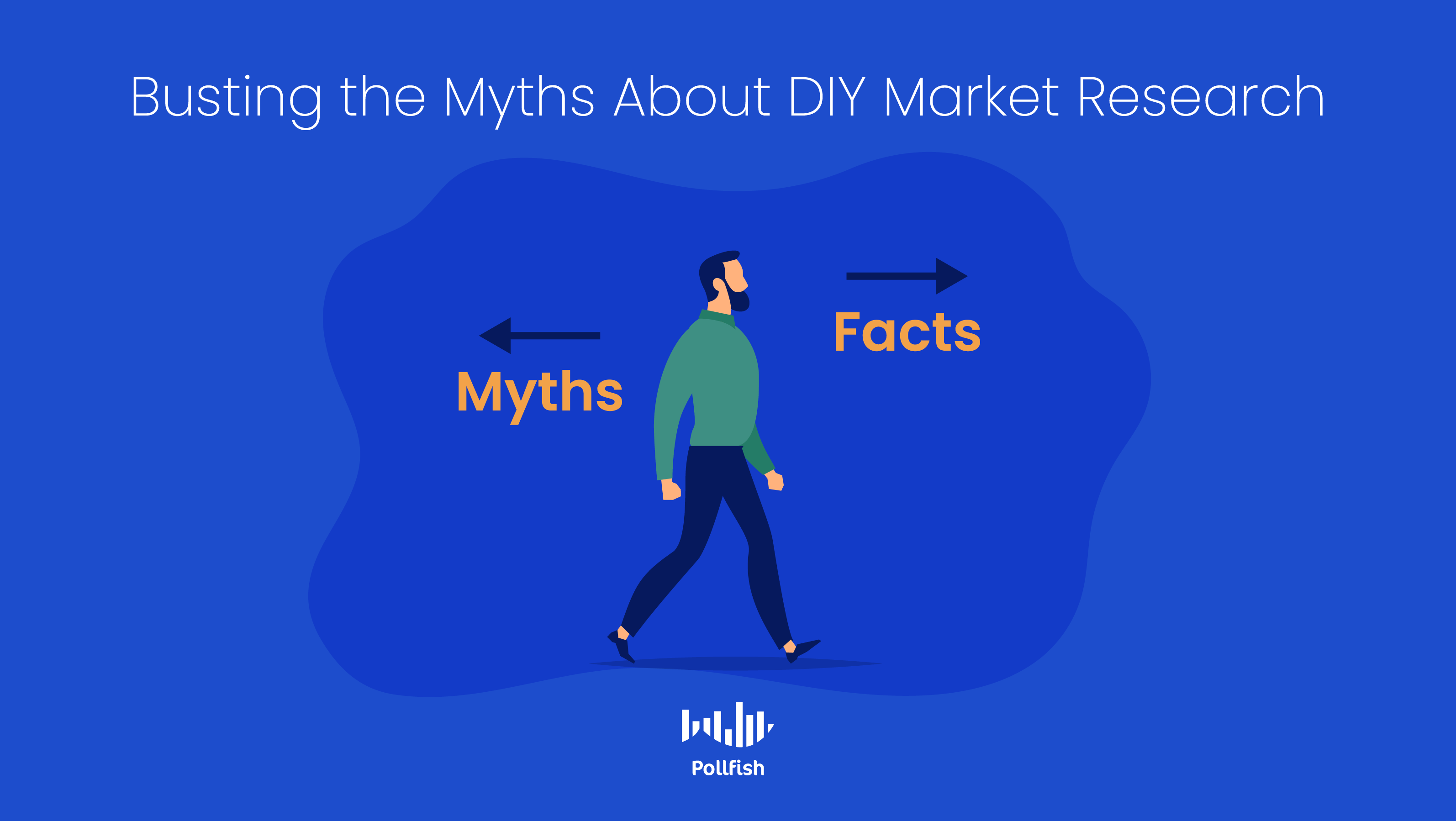
DIY market research has made waves in the market research space, which had at one point been dominated by market research panels and external research firms. Come DIY market research, which brought the entire operation in-house.
This form of research upended the industry, allowing all organizations to conduct and own their market research. In turn, businesses were able to accelerate their processes, gaining quicker results and cutting costs.
Throughout the last few years especially, businesses have had an increasing desire to use DIY research practices. This need has increased throughout COVID-19 with slashed budgets, upskilled teams and the need for faster customer intelligence.
In fact, 54% of companies that have used DIY market research experienced financial growth. Additionally, almost half of market research professionals conduct more DIY research today than they did six years ago.
Despite the convenience and prevalence of the DIY method, negative myths still abound in the space. This article lays out four DIY market research myths and debunks them while proving their value.
Understanding DIY Market Research
DIY research or DIY market research is the practice of conducting market research that any person or organization carries out themselves. As such, the party conducting DIY research can be either a professional or a non-professional.
A kind of primary research, the DIY method uses online research methods, which usually takes the form of online research software or online survey tool. This method provides an avenue to conduct both quantitative and qualitative market research.
A strong DIY research platform provides the following capabilities:
- It can aggregate data from multiple sources.
- It will reach specific demographics, locations and other category-based criteria as indicated by the market researchers.
- It will provide an interface that allows market researchers to enter the stream and test their hypotheses for various types of research.
- It makes it easy to analyze consumer behavior to identify trends and themes.
- It allows researchers to deploy their surveys across a wide network of digital properties.
- It permits researchers to send surveys to specific, targeted individuals.
- It works quickly in extracting the correct data from the qualified population.
- It allows for exports, post-survey data filtering and various displays of the data.
Despite all of its provisions and conveniences, various actors maintain that DIY market research is not for all due to several limitations and factors of inferiority when compared with traditional market research. Despite the pervasiveness of DIY market research myths, they do not prove to be accurate.
Read along to understand why, as we bust four common myths surrounding the DIY approach to research.
DIY Market Research Myths in a Competitive Space
There are long-held myths surrounding the concept of DIY platforms and research. Businesses and market researchers must understand that many of the myths surrounding the DIY approach and its effectiveness are just that, myths.
For online survey platforms such as Pollfish to truly realize their potential in the space, researchers and market research agencies should pay no heed to the myths and misconceptions about DIY market research and instead funnel their energy into finding a strong online market research tool.
Such a tool would facilitate DIY market research with little labor involved from its users, marketers, researchers and business owners. For researchers to overlook the myths about DIY tools, we’ve laid out four to debunk.
DIY Market Research Myth 1: Complexity
DIY tools have many moving parts in the backend, such as segmentation, profiling, filtering and managing projects. With these hurdles, there is therefore also a learning curve to being active users of the tool. As such, the first myth is that DIY market research platforms are more complex than they're worth using.

Although there are various components searchers would need to learn how to use, this couldn’t be further from the truth. This is because a strong DIY market research platform is made to be user-friendly, allowing its users to make your own survey in just a few steps. These aspects are the dominant traits of simplicity, diametrically opposing the concept behind this myth.
With various data visualizations such as charts, graphs, Excel files and more, researchers are in control of how they view and analyze their data. These are also easy to access, as they live on the DIY market research platform. This means businesses can cut through the middleman and access their data themselves, as opposed to using syndicated research, in which the market research firm you use owns all the data.
There is also no need to scout out research or survey panels, which are composed of pre-recruited respondents who agree to take part in a market research study. All researchers need to do is determine their audience, add in their questionnaire and launch the survey. That’s it. The DIY platform takes care of the rest.
This is a major reduction of labor, hassle and worry on the part of the market researchers using the DIY tool. As such, it is not merely a simple method, contrary to its myth, but it is one of the simplest if not the simplest way to conduct research.
Myth 2: DIY Platforms Favor Speed Over Quality
While it is true that DIY research platforms offer speed to insights and can empower researchers with an agile research strategy, they do not compromise speed over quality. Instead, these platforms offer both accelerated data collection and quality responses.
This will largely depend on the DIY market research platform you use. However, a robust platform often guarantees netting quality data only from researchers’ intended audience. It delivers this promise of quality data by preventing fraudulent responses. This involves using a series of in-platform mechanisms. These are powered by machine learning and require no effort on the part of both the researchers and the support staff of the DIY tool.
These mechanisms involve using a variety of quality checks that ensure there are no questionable respondents or faulty answers. Some of these quality checks include:
- No tolerance for gibberish answers
- Disqualification of VPN users
- Banning rule-breakers
- Barring respondents who provide one-word answers in open-ended questions that seek in-depth answers
- No tolerance for bots
- Avoidance of respondents with duplicated IDs via IP or MAC addresses, Google Advertising and mobile device identifiers
- Technical layers of quality checks
With the above quality checks and more working to eliminate any subpar data and suspicious respondents, market researchers are not sacrificing the quality of their research for the convenience of speed. Instead, a DIY market research platform couples speed with quality data.
Myth 3: DIY Platforms are Only Suitable for Simple Studies
The myth that DIY platforms lack the sophistication found in traditional research methods, such as using syndicated research or a market research agency has been long-established. After all, DIY market research platforms have given these organizations a run for their money and positioned themselves as legitimate threats.
Full-fledged market research agencies do offer value in the market research ecosystem, as they offer high-grade expertise in research design and storytelling. This gives their consumer base of market researchers a high level of quality behind their services.
However, these services do not render DIY market research platforms inferior. They are simply another route for conducting research, ones that are older and don't offer all of the conveniences that market researchers have at their disposal by using a DIY market research tool.
One such convenience is building a multi-level survey campaign, the kind that offers various question paths via advanced skip logic, a mechanism that routes respondents to the appropriate follow-up questions based on their answer to a previous question.
This creates deep and multi-pronged question paths in the surveys that researchers create, allowing them to reap granular insights and deeply explore a topic, despite the different customer personas present and their varying answers.
They can do all of this in just one survey. Thus, this capability disproves the fact that DIY market research platforms can only be used for simple studies.
Moreover, DIY survey platforms allow market researchers to segment qualified respondents in an ultra-granular way. This means they would not simply tick off demographics, psychographics and location when profiling their qualified users in their screening section.
Instead, they can qualify and disqualify respondents from taking a survey based on their answers to specific questions in the screening section, which makes the segmentation process extremely granular. Researchers will never be left wondering if the right people are taking part in their surveys.
In addition, they can add multiple audiences to their surveys, which grants researchers the ability to include multiple groups of respondents with distinct characteristics to partake and be examined in just one survey. A tool that can do this isn’t lacking when it comes to conducting complex studies.
As such, DIY survey platforms are well-equipped to manage complex campaigns that require deep segmentation, multiple audiences and varied question paths.
Myth 4: Automation Sacrifices Business Impact
This myth is centered on the idea that using a DIY market research tool removes the human-led element of storytelling available in research agencies, thereby making this kind of tool less insightful and far less impactful on the overall research campaign. This is a myth as DIY research platforms are continuously augmenting their capabilities.
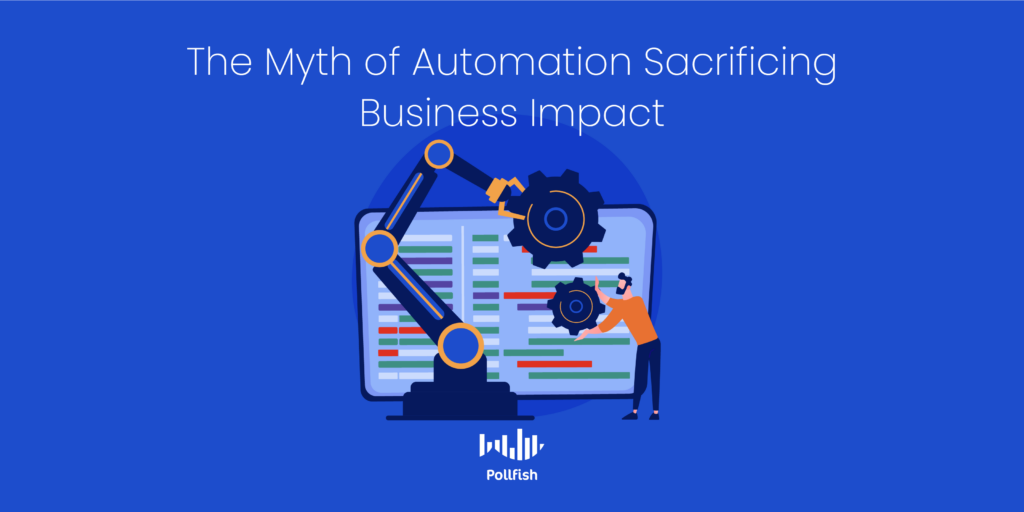
At Pollfish, for example, there are ongoing updates to the product which makes it more innovative, practical and adept at keeping up with changes in the industry.
The constant updates present in DIY market research include real-time analytics solutions and dashboards, which show the progress of a survey while it is still running. They also make it possible to access the data in various formats, visualizations and organizational styles, such as filtering post-survey data in the dashboard to focus on specific demographics and answers.
These automation-based features enable the DIY platforms to ensure data democratization, which entails all members of a business having easy access to insights, whether they are market analysts or in a far different department such as e-commerce, marketing, C-suite, etc.
These capabilities provide sufficient impact for businesses on a wide spectrum of efforts, such as marketing, sales, and advertising as they enable them to make data-driven business decisions, the kinds that are mission-critical.
Making All the Right Market Research Moves
Using DIY market research allows you to efficiently perform all the research you require for multiple projects. While it is clear as to why DIY market research myths are invalid and are just myths, it is important to understand that not all DIY market research platforms are built with the same interfaces and capabilities.
Market researchers should choose an online DIY platform with features that easily disprove these four myths and others. This way, they can safely carry out their market research campaigns, knowing that they’ll reap accurate and high-quality results.
To do so, they ought to look into a strong online survey platform, the kind that operates via random device engagement (RDE) sampling, which reaches respondents in their natural digital environments, which, in turn, cuts out survey bias.
Market researchers should also opt for an online survey platform that implements artificial intelligence and machine learning to disqualify survey fraud and poor-quality data, provide a mobile-first approach design and offer the Distribution Link feature, which allows researchers to send surveys to specific targets, as opposed to a random pool.
When you use an online survey tool of this caliber, you can rest assured that no myths, no faults or other market research issues stand a chance in marring your market research.
The Guide on How to Analyze a Market with Market Research Software
The Guide on How to Analyze a Market with Market Research Software

How to analyze a market is a legitimate business concern. After all, it would be unwise, if not downright dangerous to engage in any business operations without understanding the state of your market and all of its components.
With the plethora of insights available through secondary market research, it can be difficult to understand where to begin on conducting a market analysis. It is especially hard to cut through the noise when there are so many sources at your disposal.
Nonetheless, analyzing a market is critical for understanding how a business’s products and practices will exist in certain markets. It also brings insight into the heart of any business: the customers.
63% of consumers expect businesses to know their unique needs and expectations; 76% of B2B customers expect the same. Analyzing a market will shed light on consumers, along with the market at large.
This article is centered around how to analyze a market, the concept of market analysis and how to use market research software to strengthen your analysis.
Understanding the Concept of Market Analysis
A market analysis is a quantitative and qualitative assessment of a particular market.
It involves observing the size of a market both in volume and in value, various customer segments, customer buying behavior, the competition, the economic environment, such as barriers to entry and regulation, supply and demand and new markets.
A market analysis is designed to be a thorough assessment of a market within a specific industry. It also involves studying the external factors that will directly affect the growth of your business. To this end, it involves examining the market in relation to the aims of your own business.
With this analysis, you’ll look into the dynamics of your market and various critical components. A precise marketing analysis should include the following topics:
- The size of your target market
- Your main competitors, their offerings and marketing practices
- Your potential customers and their various segments and customer personas
- Your customer behavior
- Acceptable price points and ranges for your product for your target market
- Your competitors' strengths and weaknesses
- Industry barriers, rules and regulations
How to Analyze a Market
Analyzing your market is a multi-step process that you can benefit from if you conduct it correctly, which involves covering all areas of the market. While this may appear to be time-consuming and difficult, studying each factor at a time and following the process gradually will ease the process.
Additionally, there are various tools you can use to soothe the process, along with deriving valuable insights for your market analysis.

The following is a step-by-step guide on how to analyze a market. It will help if you seek how to do market research for a business plan, bolster your strategic planning process, use data for decision-making or generally validate any of your business actions.
- Determine the purpose of your analysis.
- While a market analysis is a comprehensive process, your business may be more in need of a particular analysis, which is where it should focus on.
- There are many purposes and sub-campaigns you can conduct for your analysis, such as: gauging your competition, understanding a new market, finding product innovations, being acquainted with laws and more.
- Determine your purpose as soon as possible, as it will guide your market analysis.
- Begin by deciding whether your purpose is internal, such as to improve your cash flow or business operations, or external, like gaining a business loan.
- Research the state of the industry.
- In this step, you’ll need to describe the state of your industry and where it’s headed.
- Use secondary resources to study its trends, size, projected growth, in-demand product and services and their innovations.
- Use secondary sources such as industry news sites, blogs, MarketResearch.com for industry reports, Ubersuggest for top industry players and SEO analyses and research associations such as Forrester.
- Identify your target market and segment it.
- This analysis will point you to your ideal customer(s).
- First, use some of the secondary research from Step 2, but to find the target market associated with your niche and business.
- You’ll need to understand your market size, who your customers are, where they live, their lifestyles and what might influence their buying decisions. Study the following factors:
- Age
- Gender
- Location
- Occupation
- Education
- Needs
- Interests
- Marital status
- Behaviors
- Views on current events, cultural trends, your industry, its competitors, etc.
- Next, segment your target market into smaller groups via market segmentation.
- Consider creating a customer profile or persona that represents your ideal customer to serve as a model for your business campaigns.
- Study your competition.
- You’ll need a strong grasp of your competitors, as this will ensure you can take advantage of their weaknesses, which you can then use to show your target market why your business is the better choice.
- Gather insights on both your direct and indirect competitors from the secondary research you conducted in a previous step.
- Study the following aspects of your competitors:
- Market saturation
- Market capitalization
- Strengths, weaknesses, advantages and hurdles
- It will be useful to conduct a SWOT analysis on several competitors.
- Establish how your competitors are different from your business. Note the strengths you have to prevent new companies from competing with you.
- For example, a better location, business patents, lower prices, a better rewards program
- Rank your competitors from least to most threatening and use this document when comparing yourself and innovating on new products, services and experiences.
- Conduct further analyses in relation to your business.
- Learn how to perform a SWOT analysis on your own business; use it and compare it with that of your competitors, especially the ones you’ve run such an analysis on in Step 4.
- Form more granular analyses on your market, economy and consumers by using these secondary resources:
- U.S. Bureau of Labor Statistics
- U.S. Census Bureau
- State and local commerce sites
- Trade journals
- Use an online survey platform to distribute surveys to members of your target market and gain their thoughts on the market, along with their needs, wants, shopping habits and more.
- Map out your own products and prices.
- Consider your price; is it on the lower or higher end of the price range in your niche, or is it somewhere in between?
- To this end, mull over the message that your price sends to your market at large.
- High prices are usually associated with quality. You’ll need to make sure that your marketing signifies that you offer a high-quality product or service if you intend on using high price points.
- High-priced goods and services need to come with a high-quality customer experience (CX).
- If your prices are lower on the spectrum, relay that in your marketing messages so that consumers will know you’re the low-priced brand.
- Forecast your initial sales volume.
- After you categorize your pricing and map out a pricing strategy, assess how much you expect to sell.
- Prior industry research will come into play in this step as you think about how much of the broader market you expect to capture.
- You’ll need to examine factors such as location, niche and your target market to understand how much they typically spend to predict your sales.
- Your forecast should be a realistic portion of the total spending in your particular niche. Be realistic, as you won’t gain 50% of the market during your first year.
- When you create your forecast, use it as a business goal. Compare your actual sales with your forecast.
- Tracking your progress will help you adjust your strategy accordingly and avoid sales disparities between your forecast and actual sales in the future.
- Consider your price; is it on the lower or higher end of the price range in your niche, or is it somewhere in between?
- Analyze your data.
- After you finish collecting all your relevant data and ensuring its accuracy, analyze it so that it is actionable to your company.
- Organize your research into distinct, digestible sections, especially in a way that is specific to your purpose, target market and competition.
- Use the following elements to organize your findings:
- An overview of your industry's size and growth rate
- Your business's projected market share percentage
- Customer buying trends
- An industry outlook
- Your forecasted growth
- How much customers are willing to pay for your products or service
- Act on your analysis.
- After putting the final touches on your market analysis, use your research and findings to take action on business.
- Use the intelligence of other businesses doing the things that you can implement in your business.
- Implement marketing strategies that you’ve found to be effective in your analysis.
- Test your analysis and form hypotheses that you can use for correlational, causal and experimental research, if need be.
- Take action on your findings by forming marketing, sales, PR and market research campaigns.
- Iterate different actions to see which garner the best results.
- Apply survey research for all your iterations and further research endeavors.
How to Analyze a Market with Market Research Software
Market research software carries plenty of weight beyond market research alone. In fact, it powers many of the activities within a market analysis. As such, you can apply it to virtually any of the steps in the previous section, as long as they are relevant to the topic at hand and you know the population to study.
This is because surveys bring you direct intelligence into your target population. They allow you to frame your own inquiries so that you gain the exact insights you’re seeking. They also provide a means of standing out from your competitors, giving you the added edge of studying virtually any demographic, should the online survey platform you use allow it.
As such, you’ll be powered with original insights which you can then apply to your content marketing strategy, your PR market research study and virtually all other areas in which you can put original insights to use. When it comes to properly executing business initiatives, you’ll find that most campaigns benefit from original survey data, given how much you can fine-tune your survey to your intelligence needs.

Then there’s the aspect of market research, the original space that makes use of survey software. Not to be confused with market analysis, market research focuses on studying a particular market with a focus on the customers in it. It is a major component of market analysis, however, as customers are the lifeblood of any business.
As a matter of fact, 52% of consumers (and 65% of B2B buyers) say they’re likely to switch brands if a business doesn’t personalize to them. Brands can only personalize to their target market effectively if they know who their customers are. This involves far more than greeting them by their name when they sign into a website. Businesses must be attuned to their behaviors, preferences, aversions and needs. Market research software such as an online survey platform is the ideal tool to use for tracking and using customer data.
Whenever you’re curious about moving forward with any business activity, whether it is forming a new product innovation, launching a product or producing an ad campaign, you can always rely on using surveys to put your ideas to the test.
An online survey platform provides you answers to any of your curiosities from your consumers themselves. However, a strong market research platform will grant you access to surveying anyone, from your customers, to your vendors, to your competitors.
Winning Over Your Market
Analyzing a market is no simple feat. However, by following the steps in this guide, you are set to form a data-rich market analysis. To reap the most quality market intelligence, you’ll need to use a strong online survey platform.
As aforementioned, this kind of market research software opens doors to a large swath of insights on virtually any aspect of your market analysis process. From customers to competitors and everyone else, a robust online survey platform facilitates your entire market analysis.
This kind of survey provider should offer an agile platform, one that can easily allow brands to engage in an agile research strategy. It should be a mobile-first platform, as the use of mobile devices dominates the digital space.
It should also include advanced skip logic to route respondents to relevant follow-up questions, use artificial intelligence and machine learning to automatically remove low-quality data, offer a broad range of filtering data options and engage respondents in their natural digital environments via random device engagement (RDE) sampling.
Most importantly, it should allow you to survey anyone. To achieve this powerful capability, you’ll need to opt for an online survey platform that deploys hundreds of millions of surveys to a wide network of digital publishers. Ideally, these are highly-trafficked websites and apps.
Additionally, to achieve this end, the platform should offer the Distribution Link feature, which allows researchers to send surveys to specific targets, as this feature is a link to a survey.
You have full access to all of these capabilities on the Pollfish market research platform, which will set you up for success in conducting a market analysis.
Diving Into PR Surveys to Boost All PR Campaigns
Diving Into PR Surveys to Boost All PR Campaigns
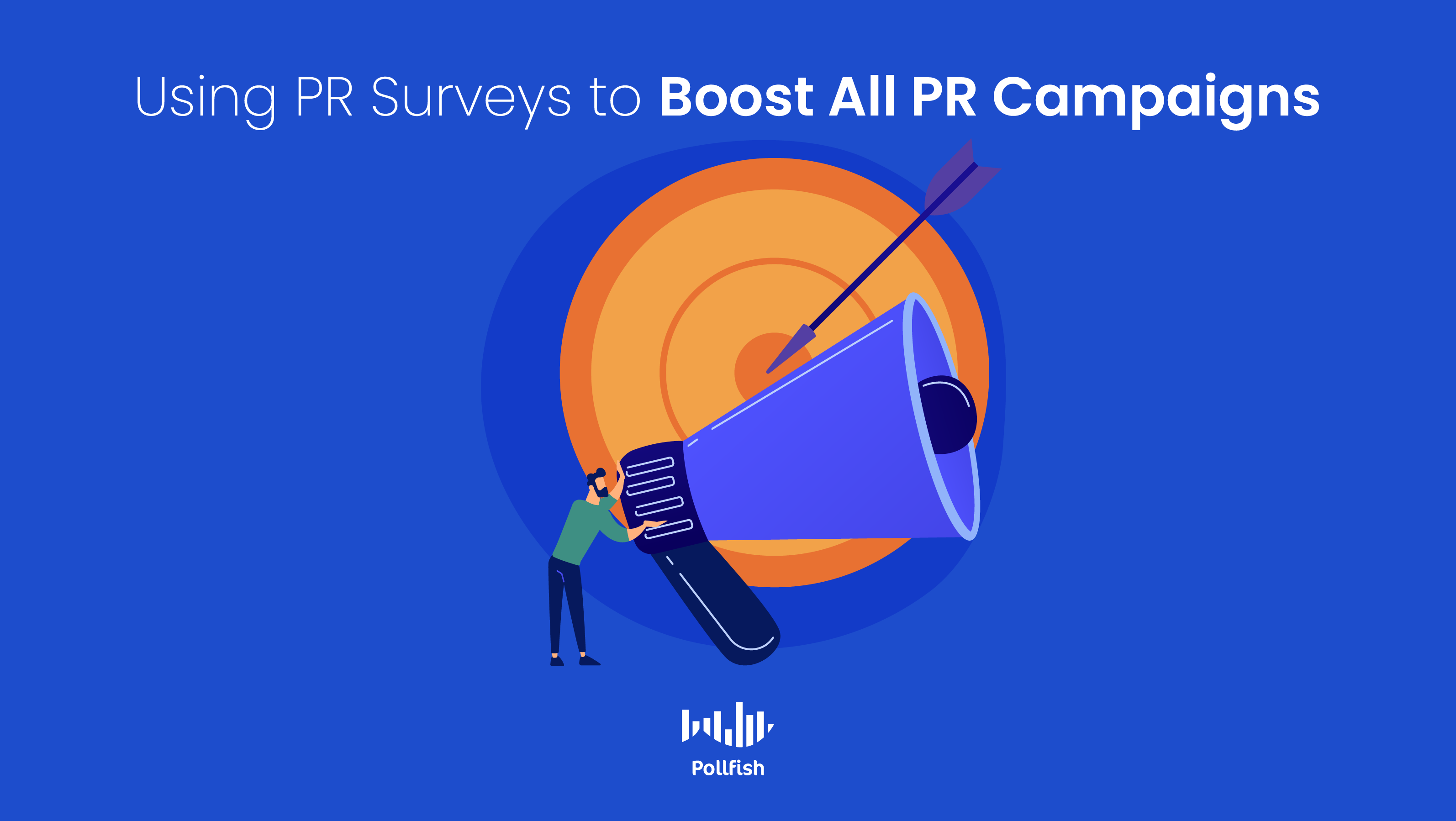
PR surveys provide companies with a lucrative way to bolster all of their PR efforts.
That’s because survey research provides businesses with exclusive findings, the kinds that allow them to differentiate themselves from other competitors in the field. Your business can use all the insights you’ve gathered from PR surveys to drive various PR campaigns.
As the public relations field continues evolving in the digital age, brands must evolve with it and use its innovations to their full advantage. 80% of PR professionals say that the future of PR lies in digital storytelling. Surveys provide the fuel for all storytelling content for a variety of media output, from press releases to journalism sources.
You can use these surveys to enhance brand visibility and positively shape the perception of your brand.
This article focuses on PR surveys, their importance and how to create and promote this kind of survey study to power your PR campaigns.
Understanding PR Surveys
PR surveys serve as the leading technique of PR polling, a method that blends PR with market research techniques, in which surveys are administered to a business’s target audience or a general population, for the purpose of sharing the results via branded content, press releases, company outreach, news, blogs and media outlets.
The questions in these surveys are created strategically, so that they do not merely obtain primary market research, but can be adequately used for broader communications purposes, such as attention-grabbing headlines and news stories.
With PR surveys, businesses can broadcast key messages of their organization while concurrently gathering public opinions of them, along with garnering original insights they can later use in PR campaigns.
As such, these surveys can touch on a wide array of topics, from current events, to things that are relevant to a niche and occurrences within a company. Given that much of PR is centered on gaining media placement and coverage, it is ideal to use a topic that will draw media attention, along with that of your target market.
The Importance of PR Surveys
PR surveys offer a wealth of benefits when it comes to PR polling and various other PR and marketing initiatives. In fact, these surveys can be the main factor behind success in today’s congested media landscape.
PR surveys allow you to craft narratives that get the attention of reporters, bloggers and their audiences. This is because these surveys are vessels to original insights on a swath of your topics of choice.
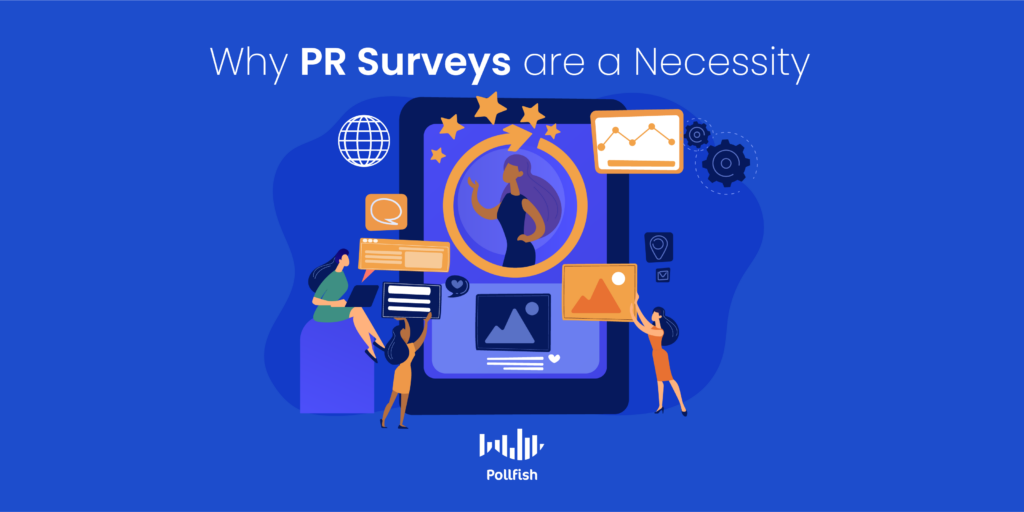
They provide businesses with exclusive insights, exceptionally important, given that 39% of publishers desire content with exclusive research. This means, you’re better off getting media placement by conducting PR surveys than you would be otherwise, including through less efficient means of conducting primary market research.
Further supporting media placement and wide dissemination, PR surveys put companies in charge of their narratives, at least at a high level. This is because you are completely at liberty to ask whichever questions are necessary and to apply any question formats, so long as the online survey platform allows it.
You should be able to freely choose from the 6 main types of survey questions and use them in your survey. You can structure your questions in a way that incites intriguing and unexpected insights. This way, your findings and their subsequent content release catch the attention and interest of news websites, readers and consumers.
As far as content is concerned, 9 out of 10 in-house communications team leaders struggle with content creation. Given that content is a major component of PR, your PR efforts are largely dependent on releasing content that draws in various key players, such as those aforementioned. PR surveys are content machines; aside from aiding your efforts with original insights, they provide narratives you can convert into stories for a wide variety of assets.
These surveys also give you a major edge in general marketing, especially when it concerns thought leadership. Rather than aggregating content or performing secondary market research, the insights you glean from PR surveys are entirely original and proprietary to your company — unless you use the syndicated research approach — in which you source a market research firm to own and conduct the study.
As such, you can power a wealth of campaigns with the original insights you extract with these surveys. This allows you to be considered a thought leader, as you can focus your studies on a particular topic of study that your competitors haven’t, or at least not with original insights.
These campaigns can include lead generation, allowing you to gain more leads by producing downloadable and gated assets such as reports, whitepapers, infographics and more. The press releases you send can link to the landing pages of these lead generation assets.
In this way, PR surveys can also boost SEO and site traffic. Since the main goal of a public relations study is to attain media attention by way of online news stories, you can lead more people to your website organically by link building.
An intriguing study will garner backlinks from other earned media placements, including bloggers in your niche and major new publications. Aside from generating attention, backlinks allow websites to rank higher in search engines.
The Content Benefits of PR Surveys
To piggyback off of the previous section, PR surveys provide a range of PR and marketing benefits, along with being strong market research tools. When it comes to content specifically, which PR is highly reliant on, there is a wide scope of content assets that your PR survey can yield.
These assets maximize the return on investment from your polling campaigns.
The following lists some of the various content assets you can churn out from your survey findings:
- Blog posts
- Press releases
- Industry, consumer or current events reports
- Whitepapers
- Infographics
- Webinars
- E-books
- Resource pages on your website
- Social media content
- Guest posts on other media websites
- Video content
- Downloadable assets
How to Create a PR Survey & Properly Promote It
When you’ve decided to use a PR survey, you should be strategic in how you carry it out. After all, the success of your PR survey study depends on the way you form the survey, along with post-survey factors.
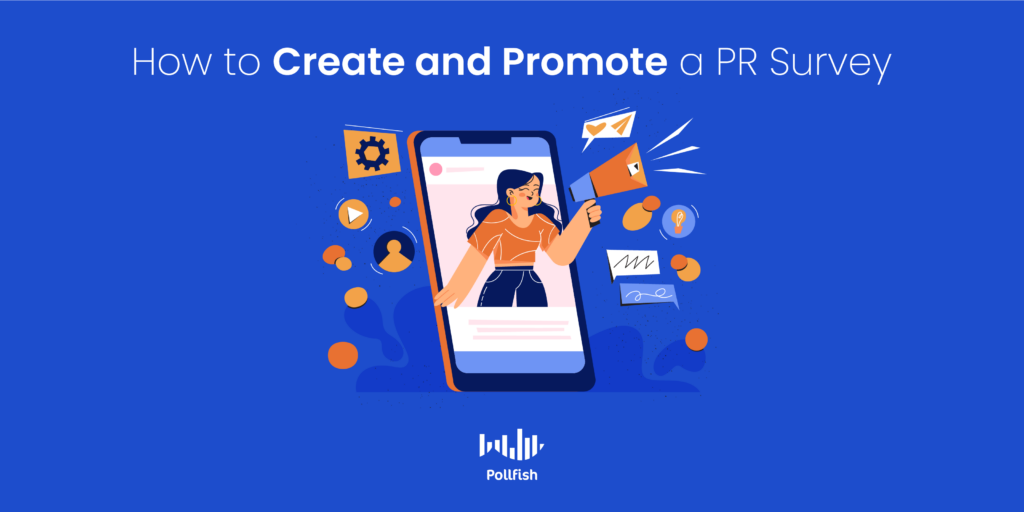
The following is an in-depth, step-by-step explanation on how to effectively create and promote PR surveys:
- Find a topic or issue that lacks information and would be interesting to provide insights on.
- This study can be centered on any of the 6 main types of research.
- Use topics that are timely and relevant to the public or to an industry to attract widespread media coverage.
- Avoid subjects already covered by other survey studies.
- Media outlets will ignore survey data that repeats what has already been made known in past campaigns.
- Journalists and other media workers seek out research that uncovers contrarian answers or something people don’t already know.
- Ask the right questions; when it comes to PR, ask questions that have a chance of extracting shocking answers, or those that are shocking in nature themselves. This is because controversial survey results often garner even greater media coverage.
- Avoid being overly self-promotion in your survey, especially if your survey studies past PR campaigns.
- Surveys that heavily rely on self-promotion perform poorly.
- Avoid being overly self-promotion in your survey, especially if your survey studies past PR campaigns.
- Check for statistical significance and consider the presence of possible survey bias.
- Make sure your study uses the proper survey sampling size before you conduct the survey. This will ensure your study carries statistical significance.
- Consider that biases are likely to occur in your survey. That’s why you’ll need to use a platform that can keep them at a minimum.
- Choose a potent online survey platform.
- Choose wisely, as the capabilities of the platform will dictate the scope and results of your survey study.
- Some platforms offer limiting features, those that won’t allow you to explore your subject as well as more well-equipped platforms can.
- Your survey platform of choice should also allow you to make your own survey in only a few steps to save you the time and hassle often associated with market research projects.
- Promote your survey.
- Since this is a PR survey, you can maximize your PR efforts on the study at large by advertising it via PR methods, such as press releases or media placements.
- Additionally, you can promote it via social media, direct mail or online ads. This should boost the online responses you’ll receive from the surveys being deployed across publisher networks.
- Consider using survey incentives.
- These will drive interest to your survey, allowing it to be completed sooner.
- You can also use incentives as a marketing tool, framing your brand in a positive light if you mention it in the survey.
- Incentives generally provide positive experiences and will allow your company to stand out from others.
Making Headway in PR and Beyond
The results from PR surveys can be powerful, convincing, and influential enough to go beyond securing media placements, but to live in the minds of your target market for a considerable subsequent period.
In order to execute useful PR surveys, you need to opt for a well-equipped online survey platform to carry out the campaign to its full potential.
This kind of online survey platform should field surveys locally or globally, use random device engagement (RDE) sampling to reach respondents in their natural digital environments, deploy surveys to a wide network of highly-trafficked websites and apps, offer artificial intelligence and machine learning to spot survey biases and disqualify poor-quality data, provide a mobile-first approach and much more.
With such a survey platform in tow, you are in good hands for conducting PR surveys and raping all of their benefits.
How to Properly Kick Survey Lead Generation into Gear
How to Properly Kick Survey Lead Generation into Gear

Advancements in market research software have given rise to survey lead generation, boosting how companies gain new leads.
As such, the correct online survey platform grants businesses another avenue for gaining new leads, instead of solely relying on traditional methods.
Generating leads is a crucial part of the sales funnel, allowing brands to progress on kick off their customer buying journey. 53% of marketers spend at least half of their budget on lead generation, given the value of obtaining new leads. For example, leads are 9x more likely to convert when businesses follow up within a few minutes.
Despite the value that generating leads brings, along with the hefty spending that goes into it, 61% of marketers say generating leads and traffic is their top challenge.
This article explores how to establish survey lead generation with the correct online survey provider.
Understanding Survey Lead Generation
This concept is borne out of the marketing practice of lead generation, which involves initiating consumer interest and/ or inquiry into a business and its offerings.
The lead in this concept is a consumer of business who is a good fit for your product or service. Also called a prospect, this business entity can be a prospective customer or a consumer who your business has interacted with, either via sales, digitally, etc.
Although casting a wide net across your target market seems intuitive, companies shouldn’t pursue all of their leads, as they are not all marketing qualified.
Your business ought to focus on nurturing marketing qualified leads, or MQLs only, as they are the leads who have indicated interest in your brand’s offerings, based on your marketing efforts. They are also the leads that are most likely to become customers.
Lead generation involves using traditional methods, such as via cold emailing and calling, list building, e-newsletter list acquisition, events or any other sales efforts. Survey lead generation is one of the latest forms of lead generation.
This practice depends solely on surveys to spawn interest and inquiry into a brand. While it may appear to be high-flown and impossible at worst, surveys are potent tools for forming leads — when used with a strong online survey platform.
That’s because surveys allow market researchers to get to the heart of any and all customer concerns, needs, desires and aversions. This allows businesses to better understand them and cater to them.
What’s best, however, is that there are other ways you can use surveys directly for lead generation.
Using the Correct Survey Questions for Survey Lead Generation
Surveys allow you to quickly gain access to questions bent on determining whether a lead is an MQL worth pursuing for your business. There are strategic ways to set up your survey questions to successfully forge survey lead generation.

These kinds of questions can specifically gauge how useful of a lead your respondents can and will be for your company.
Your business can form these questions to use them with your B2B surveys, along with your B2C consumer surveys, in order to examine your respondents’ stance on your company, their needs and readiness to either use your product or move further down the sales funnel.
Use the following questions in your survey lead generation campaign to better understand your leads and classify them as MQLs or non-MQLs:
B2B Lead Generation Surveys
- What are your prospects’ biggest pain points?
- Answer type: Multiple-selection, open-ended field option
- What kind of content do they prefer to consume?
- Answer type: Multiple-selection
- What kind of issues does your company experience in regards to [industry problem, lack, need, etc.]?
- Answer type: Multiple-selection, open-ended field option
- How do you typically work to resolve this problem?
- Answer type: Multiple-selection, open-ended field option
- Do you make buying decisions at your company?
- Answer type: Yes or no, scaled answers, ex: I make some decisions, I work with someone who does, I rarely make purchasing decisions, etc.
- Have you heard of [your brand] in regards to [the problem]?
- Answer type: Yes or no, use advanced skip logic to route them to the following question:
- Would you consider purchasing [brand] that solves your issues? Or try to use it first?
- Answer type: Yes or no, scaled answer
- Are you ready to make a purchase and when?
- Answer type: Multiple-choice such as this month, quarter or year
B2C Lead Generation Surveys
- What are your biggest pain points in [industry, niche, needs, etc]?
- Answer type: Multiple-selection, open-ended field option
- What kind of content do you prefer to see, read or consume?
- Answer type: Multiple-selection
- What kind of issues do you experience in regards to [industry problem, lack, need, etc.]?
- Answer type: Multiple-selection, open-ended field option
- How do you typically try to resolve this problem?
- Answer type: Multiple-selection, open-ended field option
- What kinds of products do you use for this problem?
- Answer type: Multiple-selection
- What brands do you typically use to solve this problem?
- Answer type: Multiple-selection
- Are you willing to try a new company for this problem/need?
- Answer type: Yes or no, scaled answers, ex: I might consider it, I might consider it only if the price is right, etc.
- Have you heard of [your brand] in regards to [the need/ problem]?
- Answer type: Yes or no, use advanced skip logic to route them to the following question:
- Would you consider purchasing [brand] that solves your issues? Or try to use it first?
- Answer type: Yes or no, scaled answer
- How important is the price in your purchasing decision?
- Answer type: Scaled answer with the range of not important at all to extremely important
How to Leverage Surveys for Survey Lead Generation
Aside from using the above questions to gauge whether your respondents would make qualified leads for your business, there are other techniques you should consider to establish survey lead generation.

You can hammer out your surveys in a way that makes your business appear more attractive to your target market, thereby allowing you to obtain more leads. There are several approaches to achieve this end. They include the following:
- Fully understanding customer pain points.
- Understanding customer pain points is crucial before customers begin their customer buying journey. If you don’t understand their basic needs and issues, you won’t be able to cater to them, whether it is in your messaging, product or experiences.
- You can push your prospects further down the funnel faster by refining your marketing collateral. To do this, you can survey your target market specifically on their pain points. This will give you insight into what keeps your consumers from buying and how your company can help them.
- If you mention your business explicitly in these surveys, you are positioning your brand in a good light, one that shows your customers that you care about rectifying their issues and fulfilling their needs.
- Increase satisfaction
- Surveys allow you to increase the satisfaction associated with your brand. To do so, you would need to directly mention your brand, including its logo, slogan, services offered, company news, etc.
- You can increase satisfaction via surveys by offering either monetary or non-monetary survey incentives. Everyone loves perks and when it comes to your business, it’s beneficial to let respondents know that their incentives come specifically from your business.
- You should also ask specific questions on what your respondents are specifically looking for from your company and what you can do to better serve them. This will show them that you care about them as individuals. This also allows you to use these insights to later take part in marketing personalization.
- Improve your content strategy and nurture programs
- Surveys allow you to refine your content marketing strategy by seeking out the following from your target market itself: how customers consume content, their content preferences and stage in their customer journey.
- Being able to understand what kind of content drives more customers’ time on site and what kind resonates with them will ensure you create high-performing content each time. Additionally, it will help you form better nurture programs, from drip campaigns, to social media content, webinars and more.
- By choosing the correct insights to inform your content strategy, such as the format, topics and more, you can establish smart lead nurture programs. You can do so by funneling your respondents into the appropriate content streams based on their responses, in turn sending them engaging, educational, and convincing content.
- Identify the Best MQLs
- You can conduct market segmentation with surveys to get more closely acquainted with the makeup of your target market. This allows you to identify and categorize your various groups of customers into customer segments.
- You can also identify customer personas as a means of further organizing your consumers into distinct individuals.
- When you segment your customers, you can also find the most ideal marketing-qualified leads. When analyzing your consumers, surveys allow you to find which customer segment and persona has the largest amount of MQLs.
- You can also route MQLs to pages that used lead generation, such as landing pages, contact forms and more, but you would need an online survey platform that offers advanced skip logic to route respondents to relevant follow-up questions and links.
- Create referrals and build customer advocacy.
- By using a survey type that asks respondents to rate their likelihood of referring your company to others, you can gauge whether your respondents are detractors or brand advocates.
- Use a scaled survey, such as an NPS survey to discover how customers rate your company in terms of their willingness to recommend it.
- You can create brand advocacy by having customers refer your company to others across media and outlets. Brand advocacy is an organic means of creating lead generation by having loyal customers refer your business.
Making the Most of Your Leads with the Right Market Research Platform
It’s more important to stand out among the crowd that is your niche in the present day of expanding ecommerce and phygital companies. Doing so will allow you to boost your lead generation and acquire loyal customers.
Lead generation is not without its challenges. In order to crack all these challenges, you ought to conduct market research on your consumer base to lure it to your brand. To conduct market research, you need to use robust market research software, the kind that provides high-quality data and speed to insights.
A good example of this is an online survey platform, the kind that offers a mobile-first approach for agile research, random device engagement (RDE) sampling to reach respondents in their natural digital environments, artificial intelligence and machine learning to disqualify poor-quality data and fraud and much more.
This kind of online survey platform will augment all of your lead generation efforts, as surveys get to the heart of customers, allowing you to identify MQLs, better serve all your consumers’ needs, convert them and even forge brand advocates.
Discovering the Correct Survey Sampling Size for Your Market Research Study
Discovering the Correct Survey Sampling Size for Your Market Research Study
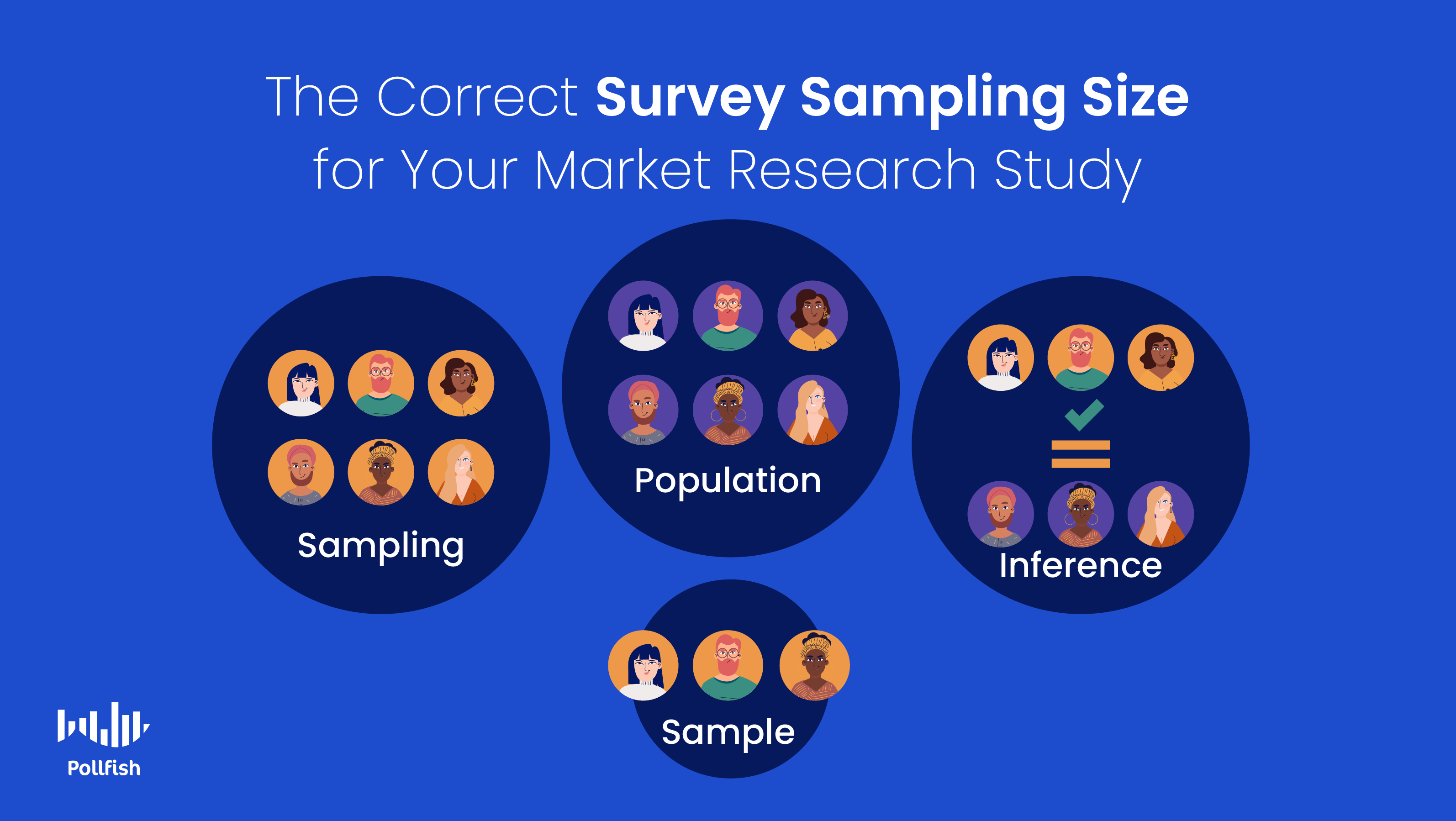
Determining the correct survey sampling size is necessary for establishing a statistically valid survey study. A well-founded survey study must be correctly designed and feature accurate conclusions, those that properly reflect the views of its target audience.
Although it is impossible to survey every member of a target population, your survey findings should be an accurate representation of the studied population. That’s where determining the correct survey sampling size comes into play.
However, even with the proper sampling size in tow, all surveys will undergo some degree of the sampling error. This is because surveys don’t extract the thoughts of every member of a population. Therefore, some findings will be inaccurate.
This article explains how to find the correct survey sampling size, its importance and the sampling size in relation to the margin of error.
Understanding the Survey Sampling Size
The survey sampling size refers to the number of respondents that take part in a survey study, which is also called the sampling pool. Used in market research and statistics, this size is usually determined with regards to the estimated size of the entire population under study.
This sampling pool is composed of a random sample of respondents who represent the studied population at large, as opposed to making up the entire population being studied, as it is impossible to survey every single member in a targeted population.
Market researchers need to determine the proper sampling size for all kinds of survey sampling methods, including probability or random sampling and non-probability or non-random sampling.
Aside from being calculated to find the size most appropriate for representing a large population, the survey sampling size is also useful for reducing the four types of sampling errors.
To determine the correct sampling size for your study, you’ll need to calculate it using several variables. (More on this in a later section).
The Importance of the Survey Sampling Size
The size of your sampling pool should never be random or made at a whim. Otherwise, you’re risking the quality and accuracy of your survey study. The survey sampling size is crucial on a number of fronts.
It is critical to market research campaigns, in that the sample size influences two statistical properties: the precision of our estimates and the power of the study to draw conclusions.
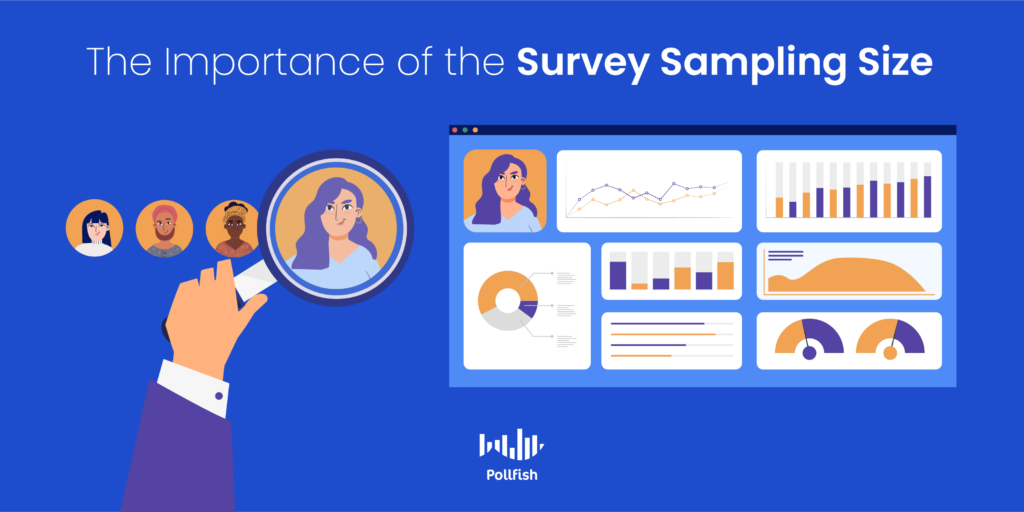
The survey study you run will always have some margin of error in the study results. This influences the precision of the survey results and their use to make predictions. Although this error is inevitable, it can be reduced with the correct sample size.
Larger samples are usually associated with a smaller margin of error. This makes sense when you consider the thousands and even millions of consumers that can fit under one segment of a target market, which can be the target audience of a survey campaign. As such, the larger your sample size, the more insights you gain that represent this audience.
However, there is a point when increasing the survey sample size has no impact on the sampling error. There are also plenty of instances when failing to use an appropriate sampling size undermines the entire study.
You should therefore be careful when calculating your survey sampling error, as both a sample size that is too large and too small will have substandard results.
What Happens When a Sample Size is Too Small
When a sample size is too small, its results will be inconclusive and, in many cases, such as in experimental research, unethical. Thus, in these cases, you won’t be able to make accurate predictions or take actions that require testing, as they may be dangerous. For example, you can’t expose humans or lab animals to possible risks associated with research.
Additionally, the data from this kind of sampling size will yield a disproportionate number of respondents with anomalous answers. These will skew the results, so you won’t retrieve an accurate understanding of the entire targeted population.
What Happens When a Sample Size is Too Large
Using a sample size that is too large is wasteful on both time and resources. It relies on more respondents than is necessary to carry out the survey campaign for accurate findings. With surplus data, the study is not representative of its target population.
This kind of sampling size will also incur more expenses to run the study, which could and should have been avoided.
All in all, an appropriate determination of the survey sampling size for a survey study is an essential aspect of the design of this kind of study.
How to Find the Correct Survey Sampling Size
As aforementioned, determining the correct survey sampling size involves using four variables. These are the population size, margin of error or confidence interval and sampling confidence level.
Once you’ve gathered the information you’ll need to determine the value of each, you can then proceed to the survey sampling size formula and simply plug them in.
Population Size
This variable refers to the total number of people in the population that you seek to survey. When dealing with broad populations, this size will likely be an estimate. For example, the population size of New York City is about 8.419 million people. A much smaller population, such as that of employees, is going to be definite.
Margin of Error
Also called the confidence interval, this is a percentage that relays how much you can expect your survey results to reflect the views of the overall population you’re surveying. Market researchers ought to aim for a smaller margin of error, as the smaller it is, the closer you’ll be to the exact answer at a given confidence level.
Essentially, it answers how much error you’ll have, which dictates how far a percentage will stray. For example, if 70% of respondents said yes to a particular question, with a margin of error of +/- 5%, then the correct percentage is straying by 5% points in either direction. As such, the true percentage is between 65 and 75%.
If you need to determine your margin of error, use the Pollfish Margin of Error Calculator.
Sampling Confidence Level
Although it has a similar name to the previous variable, this is a separate input, dealing with how confident you can be that the population would select an answer within a certain range. For example, a 95% confidence level means that you can be 95% sure the results lie between two certain numbers. The three most common confidence intervals are 90% confident, 95% confident, and 99% confident.
Standard Deviation
This variable Is an estimate of how much your responses will vary from each other and from the mean number. It studies how much individual sample data points deviate from the average population.
A low standard deviation shows that all the values will be situated around the mean number. A high standard deviation means the values are spread out on a much wider range and have very small and very large outlying figures.
Use the standard deviation of 0.5 to make sure that your sampling pool is large enough.
The Next Steps
When you have determined the value of each variable, fill them into the calculation in the section below. The following is a breakdown of the variables:
N = population size
E = Margin of error (percentage in decimal form)
Z = z-score
P = standard deviation
The z-score is the number of standard deviations that a given proportion is away from the mean. To find your proper z-score, use the table below as a reference:
| Desired confidence level | Z-score |
| 80% | 1.28 |
| 85% | 1.44 |
| 90% | 1.65 |
| 95% | 1.96 |
| 99% | 2.58 |
How to Calculate the Survey Sampling Size
Now that you understand each variable used to determine your ideal sampling size, use the following formula to calculate the correct survey sampling size for your particular survey study.
The formula is:
Sample Size = (Z² x P (1 - P) / E²) ÷ 1 + ( (Z² x P (1 - P)) / E² N))
Please refer to the following image for a more visual representation:
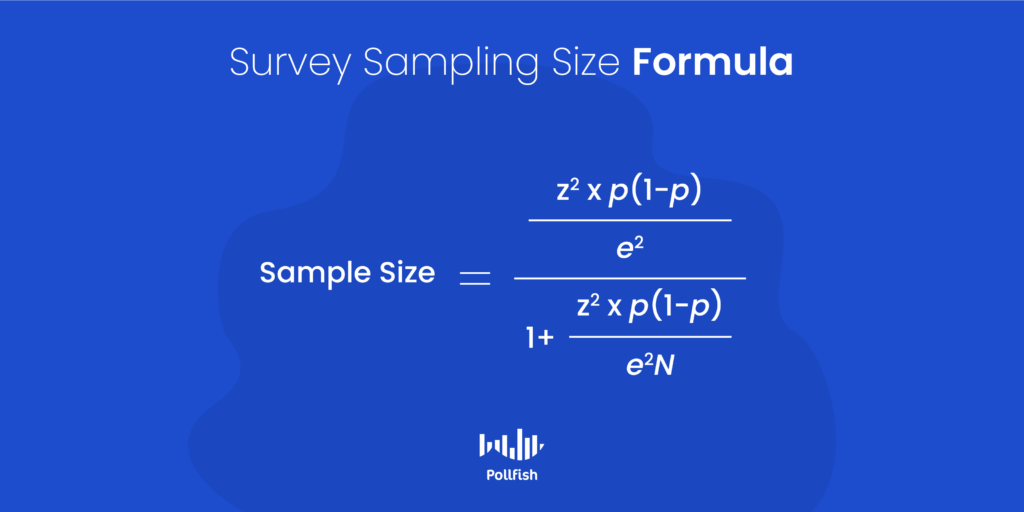
If you prefer a more efficient way to determine your sampling size, refer to the Pollfish sample size calculator.
Survey Sampling Size Tips
Calculating your sample size can be a complex process for those not familiar with statistical calculations or who don’t perform mathematics in their daily lives. There are a few key considerations that will help you make sense of the confusion.
Firstly, if you want a smaller margin of error, you will need to have a larger sample size given the same population. Next, if you seek a high sampling confidence level, you’ll need a larger sample size.
If your survey sample size becomes too big to handle, you can adjust the results by doing the following:
- decreasing your confidence level
- increasing your margin of error
Doing so will increase the chance for error in your sampling pool. However, it can also significantly decrease the number of responses you’ll need.
Optimizing Your Market Research with the Right Sampling Size
To optimize the findings of your survey study, you’ll need to use the correct survey sampling size. The correct sampling size will solidify the accuracy of your data and posit you as more of an authority figure in any of the six main types of research.
Additionally, it will give you peace of mind that the results you’ve extracted are accurate and can be used to take action, whether it is for a business or a research study in other fields.
In addition to an accurate sampling size, you’ll need a strong online survey platform to carry out all your survey campaigns.
We suggest using a strong online survey platform, one that offers agile market research and engages respondents in their natural digital environments via random device engagement (RDE) sampling. It should also be designed via a mobile-first platform, as mobile devices dominate the digital space.
When market researchers use an online survey platform with these capabilities, they are setting themselves up for success in all their survey campaign needs.
Driving Demand with Market Research Software
Driving Demand with Market Research Software

Driving demand is a constant need for all businesses, whether you operate a fledgling startup, or a long-established company. As one of the central goals that ensure business success, driving demand through lead generation is a top priority for marketers.
That’s why you need to focus your marketing efforts on an agile research strategy, the kind that doesn’t merely provide consumer research, but enables you to take meaningful action. Ideally, the actions you take should be effective in heightening the demand of your business's offerings.
In fact, 44% of marketers say that measuring the ROI of their demand generation initiatives is their top priority for 2021. While it is important, driving demand has its fair share of challenges.
This article explains how the correct market research software can be used for driving demand, whether it is for a product, a subscription, a service, or an experience.
The Importance of Driving Demand
Driving demand goes far beyond merely mustering desire, as it involves all feelings of interest and attraction from the customers towards a company. When businesses drive demand, they are improving across other key marketing functions and strategies.
A business with high demand requires funneling less attention and resources to brand awareness, as a significant portion of its target market doesn’t just already know about the business, but desires it in some way.
Additionally, businesses that excel in driving demand have larger levels of brand equity, the idea referring to the value that a brand derives from the state of having a recognizable name. When brands have high brand equity, they are well-known and achieve success. Businesses with high levels of demand thus produce equity, since, the more consumers seek it and its offerings, the more prominent it becomes in its market.

Brands with high demand also have a symbiotic relationship with cultural trends, in that these brands are responsible for forming new trends, as well as supporting existing ones. This too, raises a business’s popularity and equity.
What’s more, is that when a business becomes culturally relevant, it becomes deeply ingrained in the minds of its target market, along with those who are outside of it, who may one day become customers. This is to say that this kind of brand becomes harder to forget, thereby springing to mind when a customer thinks of their needs or a cultural trend.
Finally, when a brand exceeds in driving demand, it is building a relationship with its customers, paving the way for consumer loyalty, in which a target market chooses one brand over others in the same niche. This is especially important when it comes to establishing customer retention, which is more profitable and less expensive than customer acquisition.
When a business secures its customer retention within its customer base, it is able to increase the customer lifetime value (CLV) of many of its customers. This value expresses the profitability a customer will provide for a brand within their entire relationship with a business. As such, brands must first retain their customers, so that they build their CLV.
Driving Demand Across Various Functions
Driving demand is not merely a product-centric concept. On the contrary, it deals with generating conversion-bent desires and interests within many company aspects across your target market.
For example, some sources of demand include those found in your digital experience, such as a webinar you host, your social media content or your general site content. Additionally, demand can spring from other aspects of the customer experience, such as an enjoyable on-site shopping experience or interactions with your sales representatives.
The more functions and aspects for which you summon demand in your business, the stronger the demand for your company will be.
Fortunately, the proper market research software will allow you to garner customer and general market intelligence that focuses on driving demand. Given that consumer surveys provide a wealth of insights into customer buying behavior, desires and much more, the key is to use a strong online survey platform that can easily draw out granular customer intelligence on demand in relation to your company.
Understanding the Conditions & Functions for Driving Demand
As the prior selection explained, businesses can drive demand across various business functions and conditions. Given that there are many options for driving demand, your business ought to take advantage of as many as possible.
This is not just for the sake of profitability, as one business function may not yield the intended results as might another. Since these are business functions and conditions, they also contribute to other areas of business, working hand-in-hand with driving demand, but this is not their sole function.

The following expresses all the different business functions and conditions that you can use to spike your demand. You can apply market research software to drive demand in all of these conditions:
- Product development
- Before launching a product, you need to assure that it satisfies current market demands for it to achieve any success.
- This involves taking part in the customer development process, a framework that dictates how businesses should bring a new product to market.
- You can also quiz customers on their needs by running a consumer survey that focuses on their needs and feelings about current market offerings.
- Product innovation and enhancements
- Brands must examine how their current products are perceived, where they are lacking and how they can be improved.
- You can test the efficacy and all opinions of your current products via the product satisfaction survey.
- Lead generation
- Generating leads is a must, as they are the key actors in the sales funnel, allowing brands to acquire more customers.
- You can use B2B surveys for generating business, vendor and partner leads.
- As for B2C leads, there are various marketing campaigns you can run, alongside market research campaigns to support them. This includes conducting market research for advertising.
- Customer experience (CX)
- This involves all the feelings that your customers develop surrounding their customer buying journey, including the pre-sales and post-sales stages.
- CX also involves individual interactions with a company, including individual experiences. For example, a grand opening in-store event, an interactive content asset, virtual tours, etc.
- You can apply the customer experience survey to learn what customers seek and desire from their experiences with your brand.
- Concept Testing
- A crucial aspect of establishing and marketing a new product, service or experience begins with concept testing, which allows you to gauge different concepts in relation to your target market.
- You can apply A/B testing to your surveys to directly test concepts, should the online survey platform you use offer this in-survey feature.
- Marketing Personalization
- Marketing personalization allows brands to connect with their target market, learn what best speaks to it and allows brands to cater to it more effectively, as opposed to taking the generic route.
- This drives demand, as 80% of customers are more likely to purchase when brands offer a personalized experience.
- You should rely on a market research survey to understand your target market on a deeper level, which will allow you to foster demand through personalization.
- Advertising and Messaging
- Advertisements and marketing collateral such as newsletters and website content propel consumers to make purchases.
- These messages, especially advertisements, use sponsored content and persuasion to move the needle in demand.
- Using market research software allows you to test ads before they launch, compare marketing messages and get a sense of what grabs your consumers’ interest.
Staying Ahead of Your Competition with the Proper Market Research Software
To secure your business’s success, you should never end your market research and marketing efforts with brand awareness and brand visibility efforts.
Instead, you must drive demand, as this concept doesn’t simply foster customer acquisition. Instead, demand powers your business by reinforcing the desires of your existing customers to continue patronizing your company and offerings.
Using market research techniques is an objectively potent approach to driving demand, as it allows you to study your target market and its various segments. Market research allows you to examine your customers’ needs and desires, so that you can effectively push demand in all areas of your business, from your CX, to content, to physical interactions to the products.
To conduct market research, you need to use robust market research software, the kind that provides high-quality data and speed to insights. A good example of this is an online survey platform, the kind that offers a mobile-first approach for agile research, random device engagement (RDE) sampling to reach respondents in their natural digital environments, artificial intelligence and machine learning to disqualify poor-quality data and fraud and much more.
When you’ve implemented a market research tool with these capabilities, you will be able to obtain insights into all the functions and conditions laid out in the prior section, along with other areas of business that drive demand.
Avoiding Big Data Problems and Pitfalls
Avoiding Big Data Problems and Pitfalls

Big data problems pervade market research despite the technological advances that enhance and simplify access to consumer data. As such, big data incurs various difficulties.
This is because the many types of Martech and SaaS solutions designed for market research yield massive quantities of data. Many times, this data is of no use to organizations. On the contrary, large pools of data hamper progress.
While a whopping 90% of companies say that data is key to their organization, only 3% of company respondents say they are able to act on all of the customer data they collect.
Many businesses have caught up already implementing big data, along with AI, as 97.2% of organizations invest in AI and big data. 95% of businesses say that managing unstructured data is a problem for their business.
Big data is undoubtedly a source of contention for many businesses, including the kind that provides market research. Despite its many conveniences, big data carries various issues.
This article expounds on big data problems, their implications and how to avoid them using the correct market research techniques and online survey software.
Understanding Big Data
Before delving into big data problems, you should first understand the meaning of big data. As its name implies, this term refers to the large volume of structured and unstructured data that overloads a business on a daily basis.
Big data is composed of larger, more complex sets of data, especially from new data sources. These ample data sets are often too big for traditional data processing software. Or, when they aren’t, they are still too large and complex for a business’s personnel to fully process.
When data meets “big data” status within a business, it has reached the point of being unmanageable. Although these massive volumes of data can be used to address and resolve other business problems you wouldn’t have been able to before, their sheer volume is the root of the problem.
As such, businesses struggle with big data, often leading them to render the data that they wind up collecting as unwieldy and, in the worst case, useless.
The Three V’s of Big Data
There’s more to the concept of big data aside from the high-level notion of voluminous data sets that are difficult to access and understand. There is also more to this concept than the fleshed-out definition of the previous section.
To understand the makeup of big data, you must understand its three main factors, called the Three V’s of Big Data. These represent the following:
- Volume
- Big data entails high volumes of low-density, unstructured (and sometimes structured) data. This can include data with unknown value, such as Twitter data feeds, clickstreams on a site page or a mobile app, or sensor-enabled equipment. This can equate to terabytes of data for some companies or hundreds of petabytes for others.
- Velocity
- Velocity refers to the quick rate at which data is received and acted upon. Typically, high-velocity data goes directly to memory instead of being written to disk. There are certain internet-enabled smart products that work in either real-time or near real-time that will require real-time evaluation and action on this.
- Variety
- This involves the many kinds of data available to an organization. Unlike in traditional data, big data types are usually unstructured, whereas transitional data sets are structured and neatly fit in a relational database. Big data also includes semistructured data types, such as audio, video and text. This requires additional preprocessing to obtain meaning and support metadata.
Understanding Big Data Problems
Big data problems involve a wide variety of issues that spring from big data and its nuances. To tackle these problems properly, you must first be aware of them and how they can affect your business.
While some of these problems involve the nature of the data itself, others deal with how the data is perceived, along with how workers engage with it. As such, these problems are typically twofold in nature, stemming from either the big data features or the way that they are dealt with.
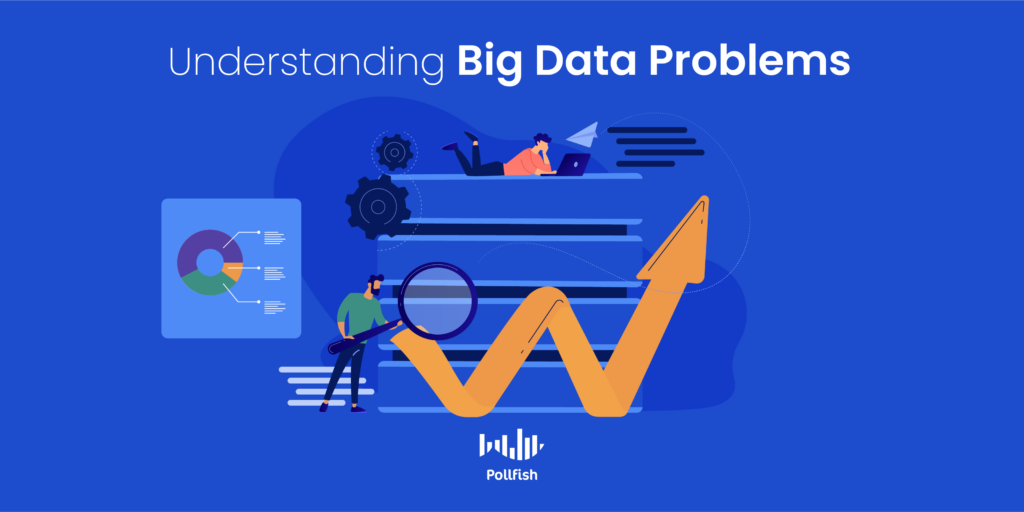
The following considers both of these kinds of big data problems:
Internal Big Data Challenges
These challenges originate from big data and its source. As such, they often deal with the features and capabilities of big data and its operating system.
- Inaccurate Data: Possibly the biggest detriment to your data, inaccurate data renders all campaigns void, whether it is a marketing email drip campaign, an ABM campaign, or a survey campaign. Accuracy is the strength in any campaign, as it will prevent workers from sending messages to the wrong people, along with reeling in the wrong consumer info, the kind that defeats the purpose of market research, which is to understand your target market at a closer level.
- Lack of Integration: Not all sources of data are designed to be integrated with other systems. This is a major problem, as it creates data silos, thereby averting teams from accessing different data sets and projects simultaneously. It becomes exceedingly difficult to interpret different data sets when they cannot be integrated. As such, data silos keep much of the data unused.
- Unorganized: Scores of big data that belong to one source are plagued by disorganization. Whether it is in the way it is stored or presented, a lack of organization makes big data difficult to read and evaluate, forestalling the use of any data for decision-making efforts. In turn, this slows down any actions that businesses could have otherwise taken based on the use of big data.
- Imprecise: While big data can be insightful and information-rich, it offers little value when it is imprecise. This means the customer insights are either too vague or lack data filtering options. For example, your big data platform may have imprecisely targeted your target market or its particular segments. It may also offer few options when it comes to filtering pre or post-results data.
External Big Data Challenges
These challenges usually result from the internal challenges of big data. However, they can also originate in purely external ways, meaning how workers and other users react to it and engage with it.
- Lack of proper data understanding: This often deals with accurate data being evaluated improperly, which yields incorrect findings and actions thereof. Employees may not understand the significance of their data, how to organize it or what to make of it. They can also simply misinterpret it. This is more common with big data given its vast amount and variety.
- Faulty Data Storage: Storing large sets of data correctly is a major external challenge, especially as it increases with the progression of time and campaigns. This makes it extremely difficult to handle this data, let alone fully assess it and put it to actionable use. Given that most of the big data is unstructured and comes from various sources such as documents, videos, audios, text files and more, you cannot find it in databases.
- Confusion with Data Tool Selection: Whether it comes from choosing between platforms, or features within one tool, confusion over these key choices can easily arise.
- Securing the big data: Securing a massive set of data is not only challenging, but a lack of it leads to data breaches, a dangerous and costly repercussion for businesses. Unfortunately, many companies are too busy to understand, store and analyze their data that they delay data security until later stages. This leaves the data in unprotected repositories that hackers can easily take advantage of.
- Lack of data professionals: Many companies simply lack data professionals, whether they are data scientists, analysts, engineers or IT professionals. This leaves companies with workers who lack the experience in working with hefty data sets. This can be problemsome even with the emergence of data handling tools, as some employees simply don’t have the aptitude for dealing with data.
- Slow acclimation: Not all big data providers offer platforms inclined toward the democratization of data. As such, this creates slower acclimation across teams, given that only a select few employees learn how to use the data. This also contributes to silos, which impede acclimation to the new team projects and actions taken after certain workers have analyzed the data.
The Importance of Avoiding Big Data Problems
Given the many utilities that big data offers, it is important to steer clear of big data problems. When you evade these problems, you can reap the benefits of big data to its fullest advantage. Essentially, the more big data problems your company circumvents, the greater your benefits will be.
Here are some of the foremost benefits that big data offers for market research and general business purposes:
- Machine learning and AI:
- Streamlines operations, removes fraud from research, reduces manual labor
- Not all big data providers implement AI and machine learning in their systems.
- Product development:
- Big data provides insights on demographics and their relation to and opinions on products.
- It helps build predictive models for new products by classifying the key features of past and current products and comparing the relationship between those attributes and the products’ commercial success.
- Innovation:
- Big data can help you determine new ways to use your insights to drive innovations. For example, using data for financial considerations.
- It helps discover trends that can inspire new ideas for products and experiences.
- Operational Efficiency:
- With big data, you can analyze and evaluate production, customer feedback and returns, which anticipate future demands and reduce outages.
- It can be used to improve decision-making in line with current market demand.
- Customer Experience:
- Companies compete on CX every bit as much as they do on the products themselves. Big data aids all CX decisions with critical customer insights.
- Big data allows you to correctly perform marketing personalization, a crucial strategy that removes the monotony from marketing and shows customers that you pay attention to their needs and preferences.
How Proper Market Research Solutions Ward Off Big Data Problems
Using the correct market research solution will ward off big data problems. This is why it is important to use a provider that offers features that ward off big data problems. First off, a strong market research platform, such as an online survey tool should offer various means of data visualizations and exports.
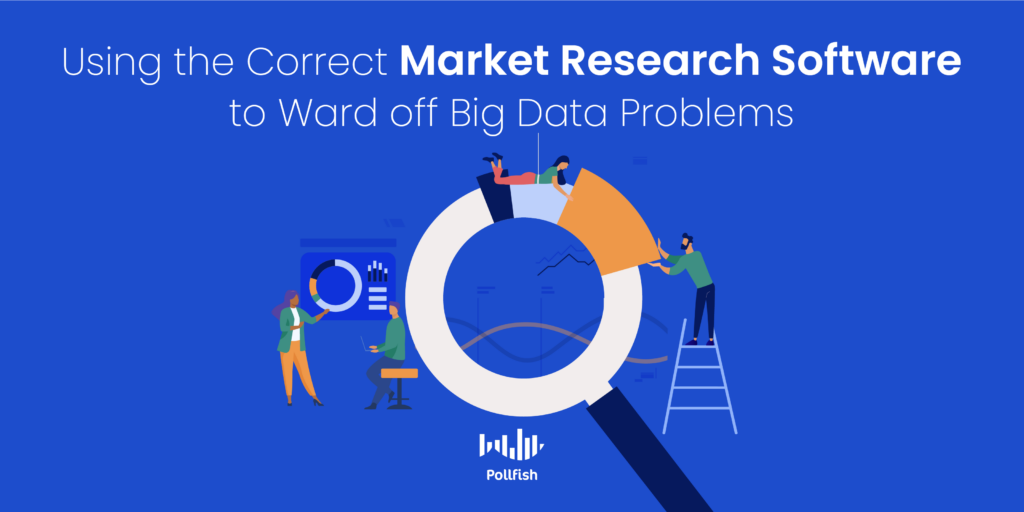
This makes the data far more accessible for various team members to view and analyze. It also provides more options to group the data differently for the purpose of conducting different analyses.
Along with accessibility, this kind of platform should offer an advanced data filtering system, the kind that allows researchers to neatly organize and view only the bits of data most relevant to their study. A strong data filtering system allows researchers to filter data across the entire platform.
For example, this includes filtering options in the screener, the questionnaire and the post-survey data results. This is especially useful to ward off big data problems, as it removes irrelevant data from view, along with irrelevant segments of the population from taking part in the study.
With this capability, researchers do not have to confront massive sets of irrelevant data, or even the kind that does not perfectly align with what they are currently studying.
In addition, this kind of platform should use a variety of mechanisms that constantly perform quality checks that protect against survey fraud. These mechanisms include bot removal, disqualifying respondents on a VPN, checking carrier consistency, testing whether respondents are paying attention, eliminating survey fraud and much more. These kinds of mechanisms remove low-quality data, eradicating various kinds of survey bias from your research.
Such a platform should cut through the noise of big data by offering extremely user-friendly interfaces, the kind that makes it possible to make your own survey in just three quick steps. After all, to scale back on big data, you would need a simplified interface.
Making the Most of Your Data
The data that you can extract from market research is a commodity in a competitive market, whether you operate a startup or a long-established business. Readily accessible consumer data allows market researchers to form large data sets to mine for all kinds of consumer insights.
However, large sets of data often hamper any market research progress, as they yield various big data problems, from inaccurate data to imprecise information, to unorganized data presentations and more.
Sampling size alone does not establish a quality set of data, nor does it reduce big data problems. As such, there is far more than the amount of collected data that makes for a strong market research project. The most important factor for reducing big data problems and conducting a strong market research campaign is the market research platform you use to conduct your research and extract the data.
A strong online survey platform offers all of the capabilities aforementioned in the previous section, along with being agile and offering a mobile-first platform, as mobile use dominates the digital space. It should engage respondents in their natural digital environments via random device engagement (RDE) sampling, as this too reduces biases.
When market researchers use such an online survey platform, they are equipped with tackling and avoiding big data problems.
The Guide to Deciding on the Best Time to Send a Survey
The Guide to Deciding on the Best Time to Send a Survey
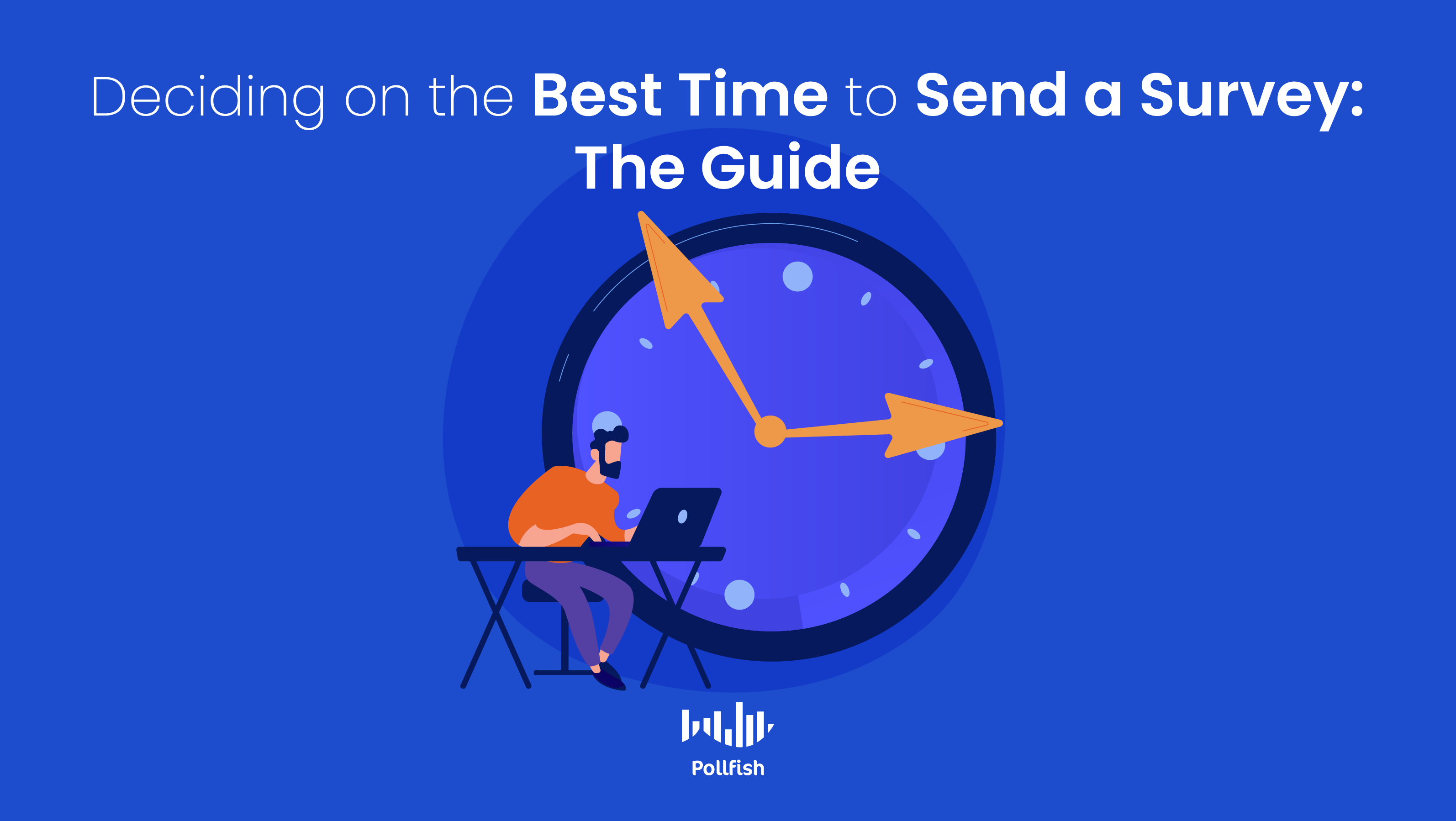
The best time to send a survey to your intended sampling pool may appear to be subjective, but it requires pre-planning to ensure profitable campaigns and outcomes. Businesses should therefore plan their survey deployment strategically.
While it is critical to correctly target your respondents, your company needs to also focus on determining the best time to send a survey so that you sustain an effective survey campaign. This is in part due to the fact that strong survey insights foster positive customer experiences.
A positive CX is a must, as 89% of consumers are more likely to make more than one purchase after a positive customer experience. As such, effective surveys reap critical insights that help brands foster a strong customer experience, among many other benefits.
This article discusses how to decide on the best time to send a survey, so that you never miss the mark on your consumer insights or employee intelligence.
When to Deploy Surveys
While your team can always use insights, you should only deploy surveys for campaigns that require the most immediate answers.
Additionally, these campaigns should be thoroughly fleshed out, meaning that they have specific purposes, goals, KPIs, sub-campaigns and of course, the full-fledged surveys themselves.
The surveys in these campaigns must have all the questions ready to go in the questionnaire and screening portions, along with the quotas set on respondent demographics, devices and all else that the survey platform allows you to define. This way, you can deploy the surveys without having to return to edit them.
While some of this may appear evident, some businesses rush through tasks to which they should have allotted more time. In fact, 20% of businesses are in a hurry to complete their tasks. The adage “haste is waste” can be applied to this scenario, as all business decisions are important and must be fully thought out before they become actionable.
Understanding the Key Moments and Campaigns Best Suited For Survey Deployment
Once you’ve determined the preliminary purpose of your survey study, narrowed down a sub-campaign or two and have prepared a few initial questions, you should pin down the key moments and other possible campaigns to deploy your survey.
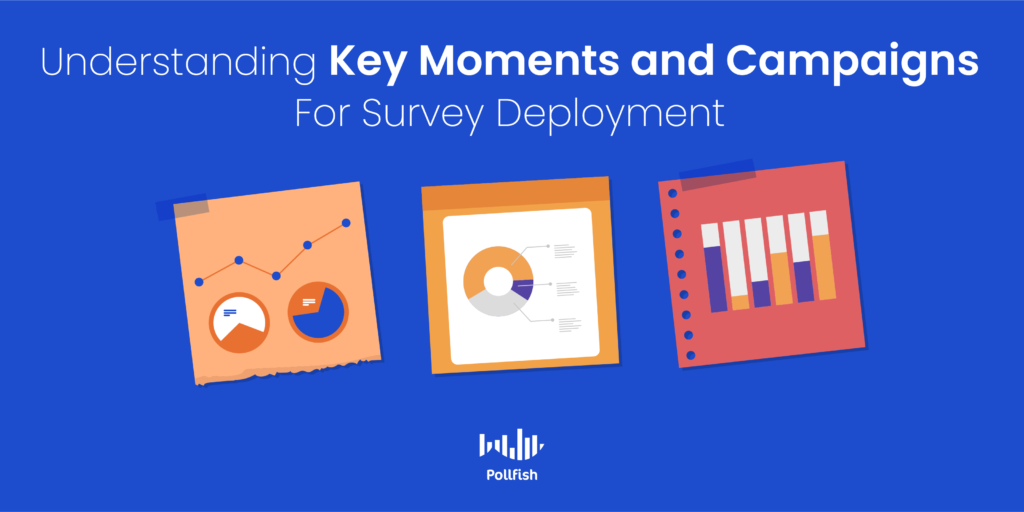
The following provides a high-level overview of a few major campaigns during which businesses should deploy surveys:
- To obtain general consumer insights
- Their thoughts on your industry, niche, competitors or brand
- Their habits, needs, wants and opinions
- When you need to conduct market segmentation
- When you seek to segment your target market into different segments and customer personas
- To get acquainted with your customer behavior
- Forming a customer behavior analysis
- Understanding customer buying behavior
- Prior to the launch of a marketing or other business campaign. This includes:
- Advertising campaigns
- Branding campaigns
- Brand tracking
- Customer development for product testing
- For collecting employee feedback
- For all HR purposes
- To improve company culture
- To boost employee recognition
- Understanding key external entities
- For better understanding partners and vendors
- This involves using B2B surveys
- For conducting event marketing analysis
- To prepare for coming events and gauging past events
- This involves using the event evaluation survey
The Best Time to Send a Survey for Customer Feedback
While there are so many purposes that surveys can be used for, there are none quite as important as those concerning consumer insights. It is the consumers, after all, who carry a business afloat and provide the source of its profits.
Knowing when the best time to send a survey to your customers can result in the difference between a low-quality and insightful campaign. This is because, as important as customer insights may be, some periods in the year or in a week are more opportune to examine customer feedback than others.
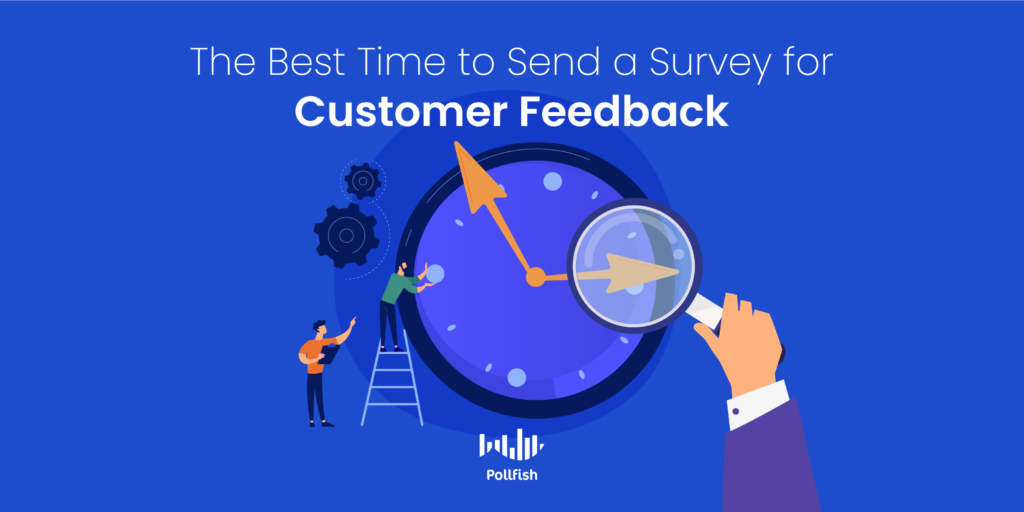
The following explains the best time to send a survey to customers, so that you reap the most insights and keep unwanted, low-insight data at bay:
- During a key milestone in the customer buying journey, for example, when your customer has signed up for a membership, a content subscription, such as a newsletter, or is approaching a patron anniversary with your business.
- After a customer comes in contact with customer service, whether through an online chat, email, phone, or via in-person shopping.
- When customers interact with your business, but wind up making no conversions, such as during cart abandonment, or opting out of signing up after a free trial.
- When customers cut their relationship with a business short during times of dropping out of their customer journey. For example, if a customer cancels a subscription or hasn’t purchased a product they typically would from a brand in a long time.
- When you’re in the midst of innovating on a new product or product feature, service type or customer experience, be it digital, physical or phygital.
You wouldn’t want to send out surveys before you understand the full scope of your project needs, especially when it comes to specific customer intelligence. You must first lay out the specific parameters of those customer intelligence needs.
The Best Time to Send a Survey During the Day
Aside from the proper time to send a survey in relation to a campaign, customer intelligence needs and the readiness of questionnaires, there exists what is known as the best time to send a survey during particular days and hours.
According to a study by CheckMarket, there are specific days of the week and times of the day that are most opportune for sending surveys to your target market. In fact, there are ideal times for sending two main kinds of surveys: B2C and B2B surveys.
You ought to use these specific times as guidelines, as they represent the most appropriate times for respondents to take surveys, which, in turn, shortens the completion time of your survey study.
The following outlines the best time to send B2C and B2B surveys in relation to the time of the week and day.
| B2C Surveys | B2B Surveys | |
| Best Day to Send | Short surveys: Tuesday Long surveys: Wednesday and Friday | Short surveys: Monday Long surveys: Monday, Wednesday, Friday & Sunday |
| Best Time to Send | 6:00 PM- 11:59 PM | Monday: 12:00 AM- 11:59 AM & 3:00 PM - 5:59 PM |
| Thursday & Friday: 3:00 PM - 5:59 PM |
Sending Surveys at all the Right Times
There is far more to ensure that your intended respondents take part in your survey campaign aside from finding your survey at the correct time. The most important aspect of the survey campaign is the online survey platform you use.
This is because this platform allows you to create and deploy the surveys. As such, you should choose an online survey platform that offers superior capabilities, such as random device engagement (RDE) sampling to reach your respondents in their natural digital environments, artificial intelligence and machine learning to disqualify poor-quality survey data and fraud, along with mobile-first design to optimize the mobile experience, given that mobile traffic is dominant, and much more.
Such a platform will ensure that you not only reach your target audience at the right time, but that a highly targeted group partakes in the survey and you receive only the highest quality responses.
How Surveys Help Make Critical Business Decisions
How Surveys Help Make Critical Business Decisions
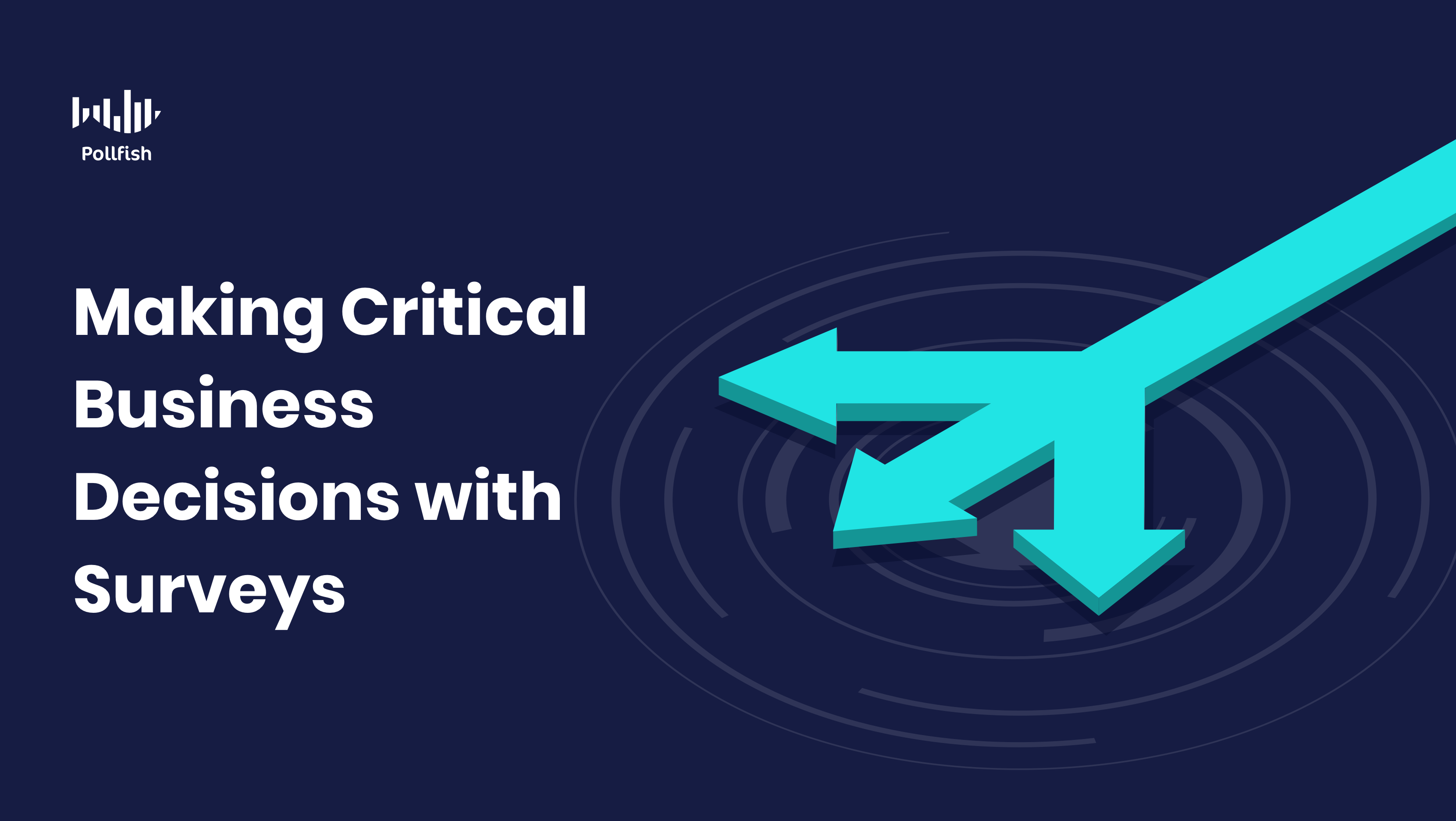
Making critical business decisions often require lengthy processes, which involve referring to your strategic planning process and business plan, along with proposals, meetings and lots of persuasion.
Rather than basing business decisions on inferences, which can originate from business documents and the advice of others, businesses ought to consider using data for decision-making. However, businesses need to take heed of context, as data that’s blindly applied is worse than useless — it’s misleading.
This is a problem virtually all businesses will come by, especially those investing in Big Data and AI. In fact, a large number of firms, specifically 64.8% of businesses invest in Big Data and AI. However, only 14.6% of firms have deployed AI capabilities into widespread production.
Businesses should therefore use data with a clear purpose, contextual insights, data filtering and neatly organized so that it is digestible and easy to understand.
This article discusses the weight of business decisions, the confusion and inaccurate conclusions springing from big data and the five key ways that surveys help businesses make crucial business decisions.
The Weight of Business Decisions & Avoiding Wrong Ones
There are plenty of decisions that executives need to make on a daily basis, from taking HR and other internal actions, to relationship-building with partners and clients, to setting goals and budgets.
It is critical for every business decision, regardless of its perceived importance, to be made with the best intentions and for the primary goal of benefiting the company in some way.
When executives and other higher-ups layout fine-tuned goals for employees, their workers will run into fewer issues and make fewer mistakes. Employees will therefore execute all that your business needs more efficiently.
It is key to note that changing business practices on a whim or when you are in a bad mood can have grave consequences. Every business decision should be carefully considered, and gain input from other employees.
Given that all business decisions carry some degree of importance, they cannot be made suddenly. Such decisions must be informed by data, particularly customer data if you’re seeking to form or test new marketing campaigns.
But as aforementioned, many businesses incorrectly use their data, as big data can be misleading, resulting in key stakeholders making the wrong decisions. This is especially true in large sets of data, as it is common to make causal links that appear to be legitimate, but represent fake statistical relationships.
Data needs to be contextual and allow researchers to make accurate decisions. As such, businesses need to conduct market research, specifically primary market research on their target market prior to making any changes or decisions.
In the mobile-first age, your business needs to make business decisions to not only suit your business needs, but to acclimate with the current mobile-first world. This involves your mobile properties, such as your mobile site and app(s), along with the way you conduct market research.
Survey research provides a strong means of gathering customer data, the kind that can help your business avoid the problems from big data.
How Surveys Help Avoid Issues and Make Business Decisions
Conducting survey research is a critical move to make when it comes to using the correct set of customer data and adapting to mobile-first. The proper platform facilitates ease of survey creation, deployment and organizes your data in an orderly fashion.
Given that surveys allow you to ask any question, set the theme of a survey campaign and form qualitative market research via open-ended questions, this kind of data provides all the contextual information your business needs to avoid the common pitfalls of big data.
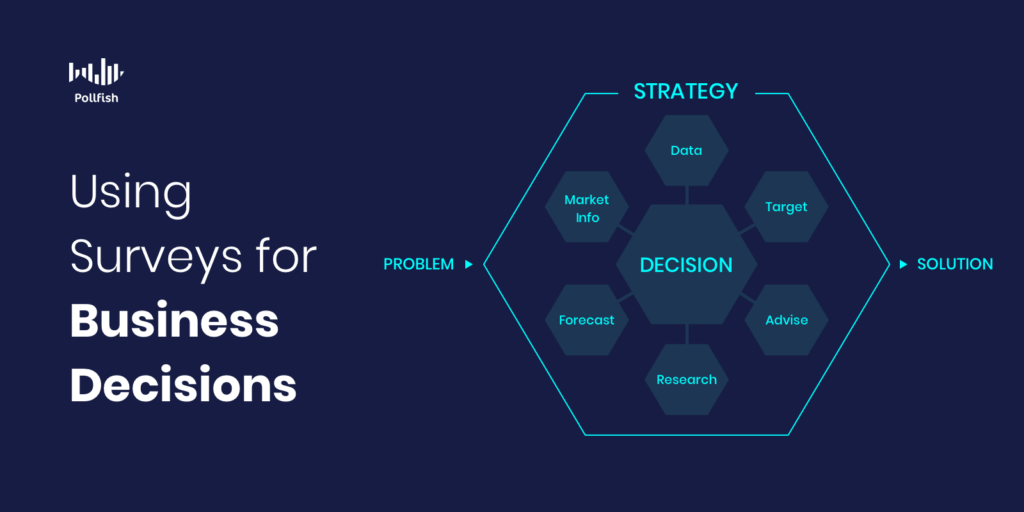
The following sections explain the five ways you can use surveys to make smart business decisions.
Testing creatives before launching a campaign
Marketing campaigns are often major undertakings that come with large price tags. To avoid any mistakes or issues, such campaigns need to first be tested before launching. Surveys steer all those on the creative side of a team in the right direction, as insights from these tools help creatives form and develop their concepts, making them crucial components of concept testing.
Surveys allow marketers and creatives to take more risks with content by first creating a survey to test different versions of a content idea. Then, they can understand the opinions and feelings of their respondents on a high level, along with examining their reactions more deeply, such as with open-ended questions, which are qualitative in nature.
Understanding different customer segments
Marketing endeavors — or any others — will never hit the mark when you don’t understand your target market, the broad group of customers that are most likely to buy from your business. In order to properly market to and serve your customers, you’ll need to understand them precisely, which includes understanding the segments that make up your target market.
Surveys make this possible, as they are a primary source of executing market segmentation, in which market researchers can divide and organize their target market into smaller groups based on their shared characteristics, such as demographics, location and behaviors. This makes it easier to form marketing campaigns, as you can design them specifically for each segment.
This technique is also ideal for market research, as it allows businesses to study their customers in a more organized and granular manner. If you don’t understand the nuances behind your customers, along with their preferences and aversions, you won’t be able to create messages or innovate on your offerings in a way that is relevant to them.
Understanding what consumers think of your competition
Surveys help you make critical business decisions by way of conducting competitor analysis. Although surveys are deployed to the masses, which includes your target market, you can use them to ask consumers for their thoughts on your direct and indirect competitors.
Whether it is about other businesses in a geographic area or other ecommerce businesses surveys allow you to understand the standing of other businesses in your market. Surveys unveil whether consumers are aware of your competitors, thus allowing you to gauge your competitors’ brand equity, along with what consumers like and dislike about those businesses and their offerings.

In this way, they can also educate you on your market at large, such as its key innovations, demands, movers and shakers, key events and more. As such, surveys are instruments for understanding both your competitors’ performance in the eyes of your consumers and their thoughts on your industry at large.
Spotting trends early
The latest trend may stay culturally relevant to your target market for a while, but it also may just be just a passing fad. Surveys help teams become attuned to cultural trends, current events and the general sentiment around them. With this tool in tow, your team can test their ideas in relation to trends and back them with data.
This includes data on where your industry and niche are heading. Surveys grant you these insights with the potential of spotting trends early on, so that your team stays ahead of the curve and can capitalize on them quickly. Surveys are the perfect tools for adapting to new trends and practices, as their results are available in nearly real-time. (This will depend on the online survey platform you use).
Get feedback on new product ideas
Innovating on products is often difficult; it would be especially unfavorable to launch a product without understanding how your target market feels about it. Perhaps the new product or feature will be useful to your consumers, but there is a chance of it disappointing them.
For example, you may think you’re adding a useful feature or removing an inconvenient feature, while your customers never needed you to take these actions, proving the adage of “if it ain't broke, don’t fix it.” After all, some features, like a USB outlet on a laptop are necessary, but brands may remove it, incorrect about their assumption that it is unneeded. In turn, customers have to hassle with finding the correct adaptor.
Thus, innovation is important, but it carries a lot of risks. As a business owner or market researcher, you need to be wary of these risks, how to minimize them and to innovate in ways that are truly beneficial to your target market. Surveys allow you to do all three, as you can assess product development by asking the right questions.
Surveys are key tools in customer development, a framework part of the lean startup concept, used to ascertain whether a product satisfies the needs of your target market. Surveys also complement an in-home use test, a market research technique that allows researchers to test a new product by way of sending it to a customer's home rather than sending the customer to a facility to try the product.
Making all the Correct Business Decisions
As a business owner or market researcher, you owe it to yourself and your team to make wise decisions to enable employees to trust you and to steer the company in the right direction. All business decisions are important, whether they involve customers, products, vendors or employees.
Surveys allow businesses to properly cater to all of these entities, whether it is marketing to a target market, innovating on products or serving your employees. This is because you can create campaigns centered on virtually any topic, allowing you to understand your target market’s opinions on anything you like.
However, not all online survey platforms are built with the same capabilities. Your business needs to find a strong survey tool that allows you to make your own survey in just three steps, uses artificial intelligence and machine learning to weed out poor-quality survey data and implements random device engagement (RDE) sampling to engage respondents in their natural digital environments, as opposed to using pre-recruited participants.
When your business leverages survey software that offers these functionalities, you’re set to make critical business decisions without hesitation.










